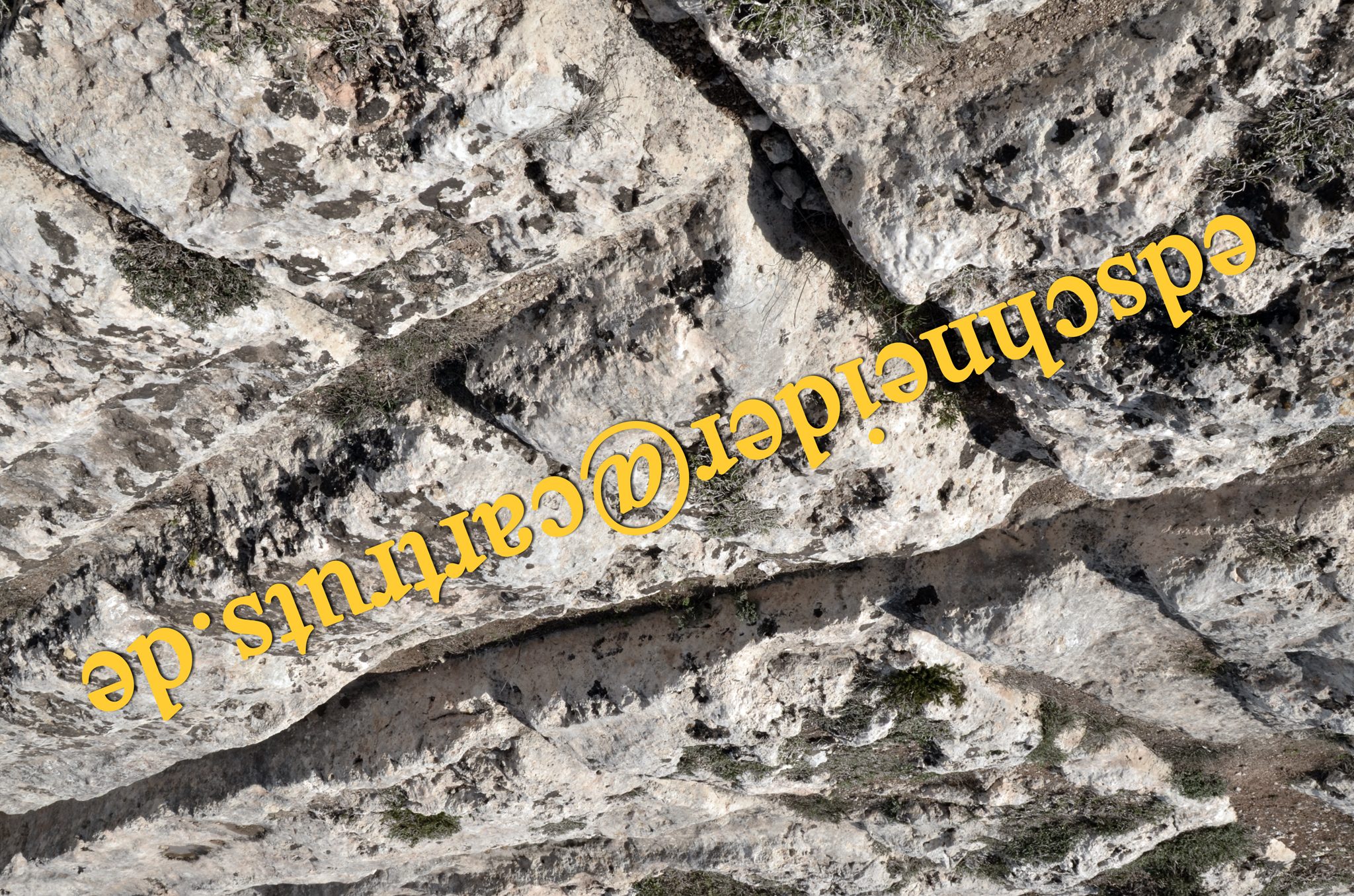An approach to an archaeological mystery
1. Introduction
On this planet exists on many continents an archaeological mystery of a special kind, which is astonishingly unknown to anyone.
We all know the pyramids in Egypt and Central America, maybe even the pyramids in China. Likewise many people are certainly familiar with other sites of an often overwhelming construction technique.
As few examples Baalbek, Puma Punku and Sacsayhuamán as well as Göbekli Tepe are called.
But then there is the riddle of cart-ruts, the tracks of vehicles that can be found at our feet in the rocks on many continents.
To be more correct: it is generally assumed that they are vehicle tracks.
No tons of stone blocks were processed and moved, no underground vaults created, no, very quiet, but no less impressive, they show themselves to the interested visitor.
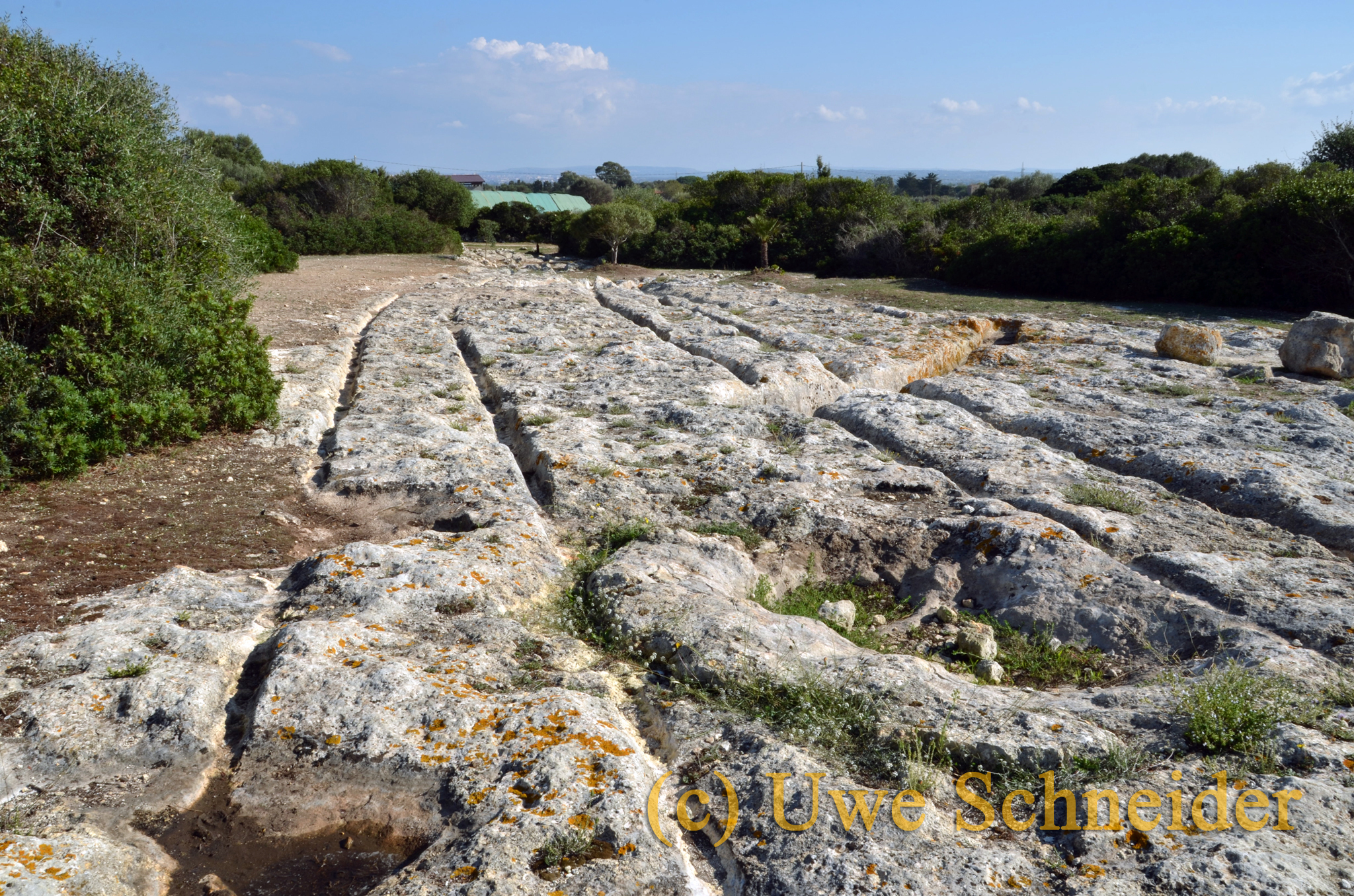
There is no certainty about their origin. It seems that this topic is somewhat neglected and little explored, if it is not even repressed.
Often their origins are blamed on the Romans or loaded on the car, but since the tracks occur worldwide, this thesis can´t be true.
Of course, loads have been moving all over the planet and these activities have certainly left their mark, but the cart-ruts have characteristics that, in my opinion, exclude ordinary traffic.
According to the current state of affairs they can be found on Easter Island, in South America, Mexico, in the USA, in the Azores, in Portugal, France, Spain, Mallorca and Menorca, in Libya and Italy including Sardinia and Sicily, but also in Germany, Austria, Switzerland, Croatia and Cyprus.
Huge deposits were discovered in western Anatolia and Cappadocia, but also in Crimea, Azerbaijan, China and Japan.
And of course, we still have the traces of Malta and the neighboring island of Gozo, which are probably the best well known of their specific kind and have first made the mystery more public well known.
In any case, my first visit to Malta in 2014 fascinated me so much that I have been always on the trail of tracks.
My concern is that people, who are interested in this topic, actively participate in building up this database, collecting information, documenting the traces photographically, and add the data into the project, by paying attention of copyrights.
2. Previous reseach and investigations
In my first research, I read an essay by Uwe Topper, who had already put together a lot of material on the subject. He writes that latest at 1794 the traces appeared in the Spanish literature. In 1877, José Sabater said: „These tracks will be the terror of archaeologists for a long time to come.“
And in 1919, writes Uwe Topper, Zuazo y Palacios made a call to all scientists and archaeologists: „We consider these Iberian ruins are the most important of Spain!“. (1)
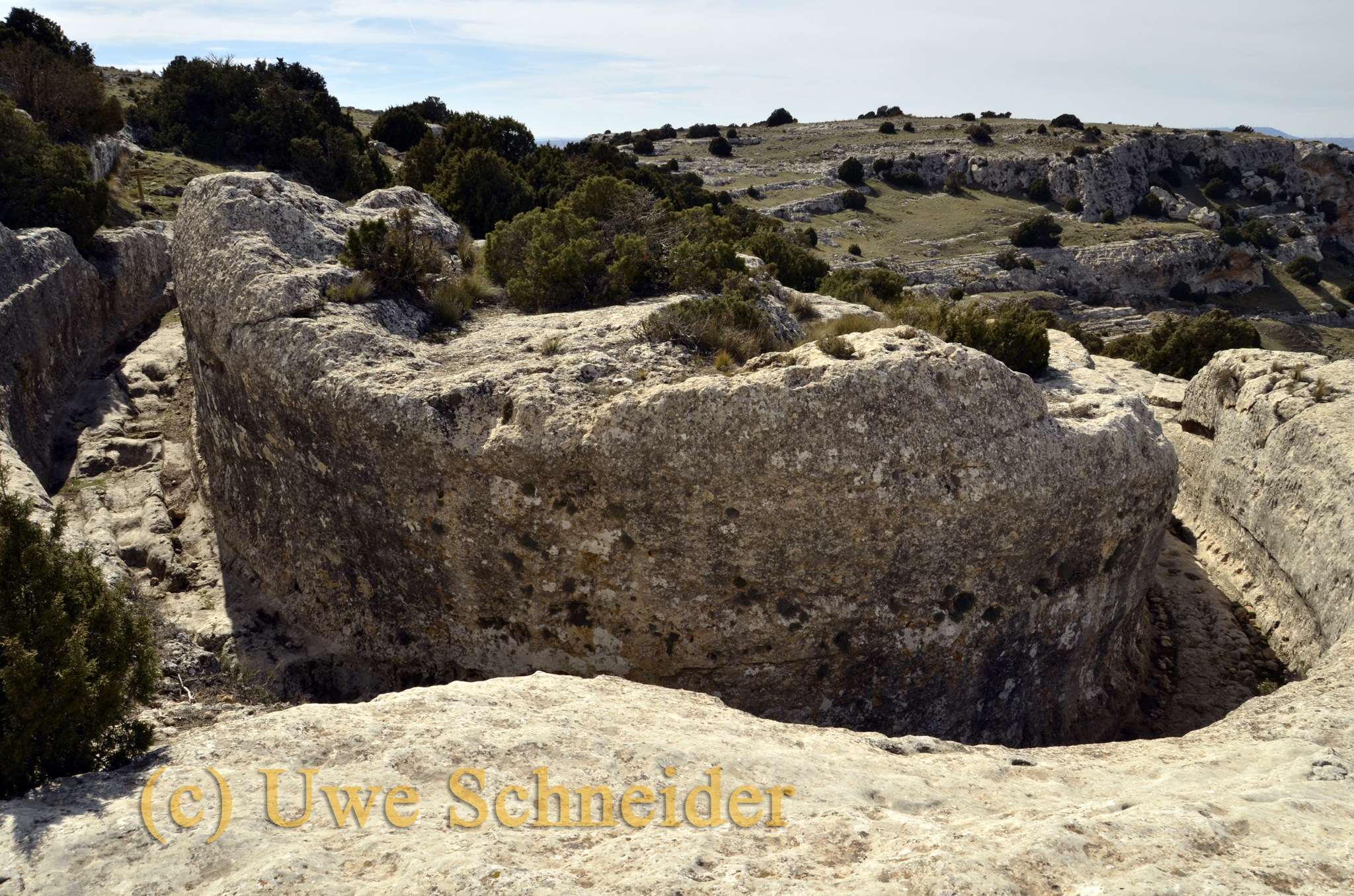
In 1893 a book by Philipp Ballif entitled „Roman roads in Bosnia and Hercigovina“ was published. The author toured this region and documented these historic routes and traces. Its origin dates back to the time of the Roman Empire, although no geological or geomorphological considerations were made. (2)
In Malta, in the 1950s, British archaeologist John Evans explored the trails and experimented with animals dragging laden tree trunks across the terrain. According to David H. Trump, another British archaeologist who studied the riddle of cart-ruts, this action was unsuccessful. Or, yes, because it showed that it is not easy to bring such traces into the hard limestone.
By the way, David H. Trump has a wonderful, albeit small, booklet with lots of photos and information about cart rutting in Malta. In this he writes that already Abela (1649), Houel (1787) and Boisgelin (1805) explored the tracks.
And he also writes: Definitive solutions seem as far away as ever. (3)
Swiss enthusiasts around Georg O. Brunner have studied the rock tracks and their enigmatic properties, as well as conducted experiments on abrasion.
A very readable article. (4)
Between 2000 and 2005, there was a Cart Ruts research project funded by the EU’s CULTURE 2000 program, involving universities from Malta, Spain and Italy. At the end, a book with the research results or a small part of it appeared at first sight.
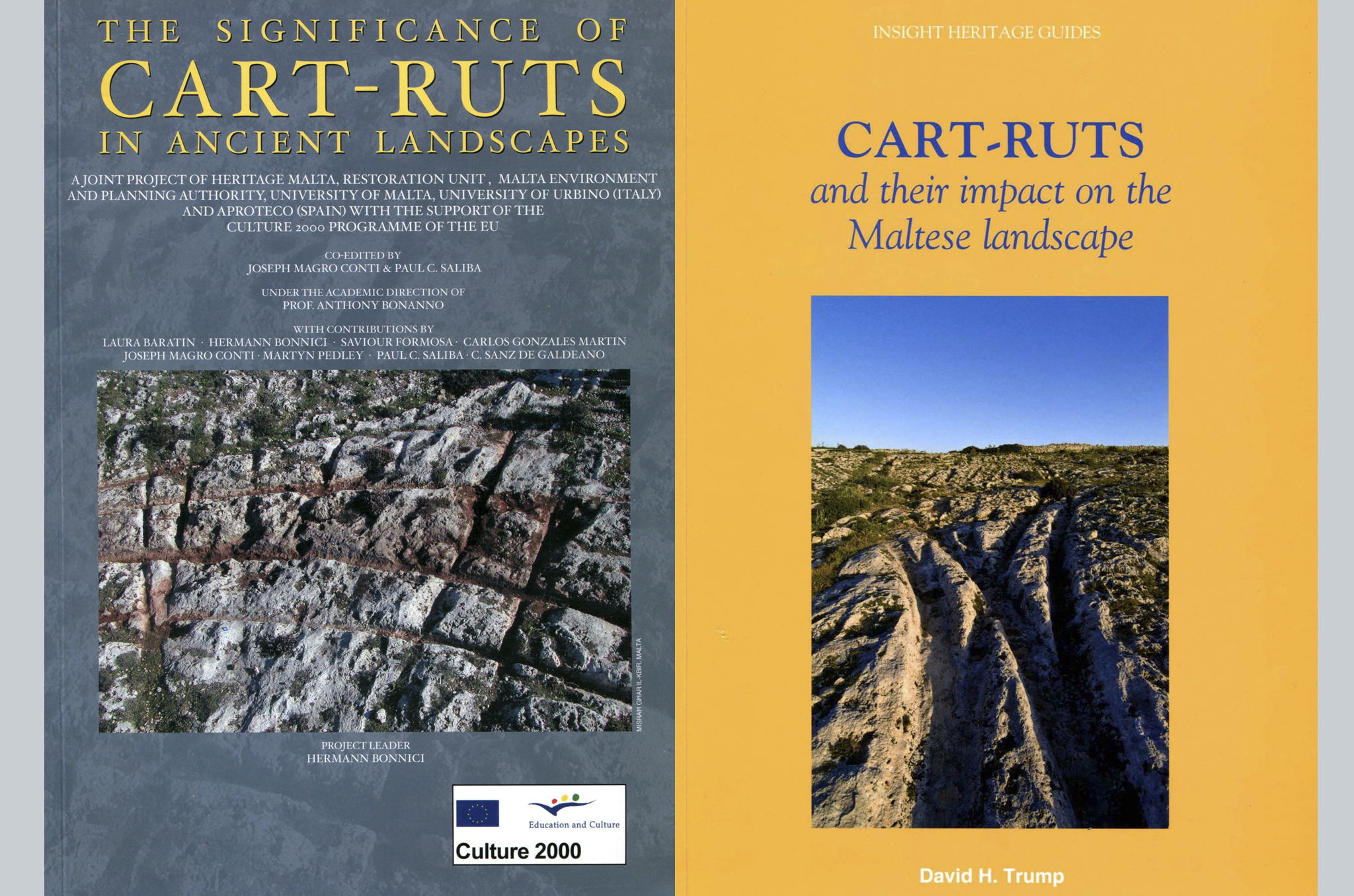
Unfortunately, the graphics and photos are often very small and not of good quality. The evaluation of the large-format, nearly 400-page book, which is only available in an English-language edition, is currently not yet completed.
As part of this project, traces were studied in Malta and Spain.
There are also listed some cart-ruts worldwide locations.
My first impression, however, is that it has been written around the subject a lot of words and that basic geomorphological investigations have not been made, but without this all theories on the subject are only speculation.
From Dr. Claudia Sagona create a theory that interprets these tracks as water channels. In the meantime, I’ve seen a lot of these tracks, also in Malta, but this idea has never come to me and I think that this theory is absolutely far from any reality. (5)
In Moscow, Dr. med. Alexander Koltypin, geologist and director of the Natural Science Research Center at the International Independent University of Ecology and Political Science, is working on this theme and other stone testimonies from former times.
Due to his numerous exploratory travels, he believes that these traces and many sign in the rock date back to the Neogene (23.03 – 2.59 million years ago).
He dates the ruins and cart-ruts to the time of 15-6 million years ago.
Large catastrophes with one to two kilometers high flood waves had hit the earth during this time and wiped out an already existing civilization,
so the hypothesis of Koltypin. (6)
This, of course, is a daring theory that can only be confirmed or disproven by professionals.
I can imagine this scenario already, because the tracks have properties that support his theory. But more in another chapter.
As already mentioned, cart-ruts can also be found on the Azores in the Atlantic, which belongs to Portugal.
From Hans Dieter Gau, a expert of the Azores and the local traces there, I learned that a project for researching the cart-ruts was found.
According to the latest information from him (November 2018) the traces can be found on all islands of the Azores!
On cart-ruts on the American continent, it should be mentioned that, according to historiography, the wheel was not known before Columbus. Who is responsible for the tracks there?
3. Properties of the tracks
„Some of them are still completely confusing, which increase their attractiveness,“ writes David H. Trump.
He brings the theme to the right point without exaggeration!
I have seen a lot of these large areas of rock formations and nowhere did the thought come up, okay, everything is clear here. Uniform wagon tracks, yeah, and then there must be in the middle of the trail signs of animal tracks. No! Nothing like that, just confusing details and I want to say, everywhere other bizarre apparitions.
Strikingly, there are two types of cart-ruts:
Some have a very narrow base width with an occasional arcuate cross-section in the track and a smaller track width than the second type, which has a much larger flat base and a larger track width.
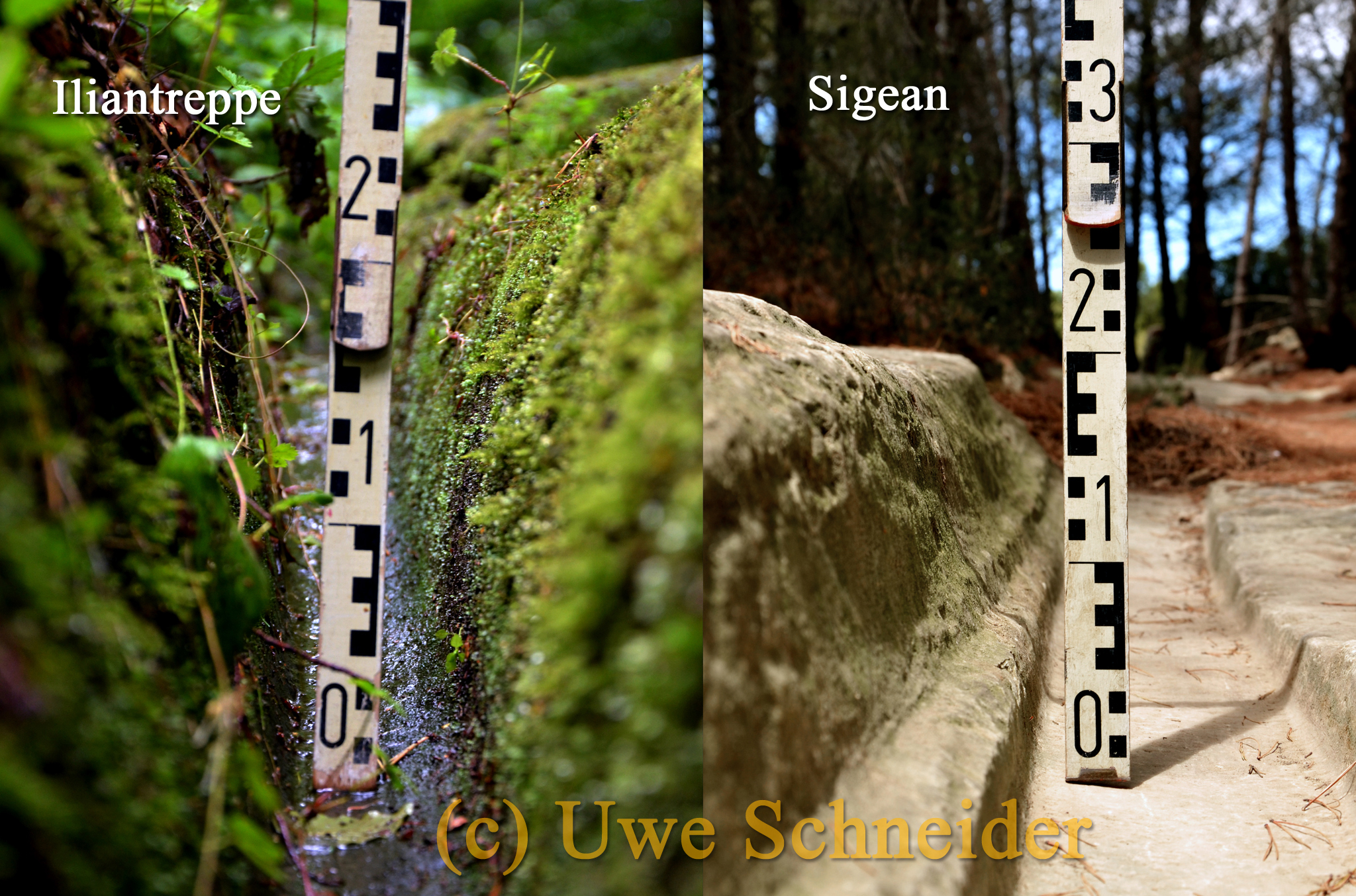
Let’s start with a 30 m track near Sigean near Narbonne, southern France. Very clean and elegant, cart-ruts pull through the solid and massive limestone, then at the northwestern end of the well-cleared lanes a surprise awaits us. Looking to the northwest disappears the left lane, as if the vehicle had driven on only on the right side.
You only can see the beautiful smooth surface of the limestone, no sign of a trace, only the adjoining surface appears to have been sanded off a bit.
How is something like this possible?
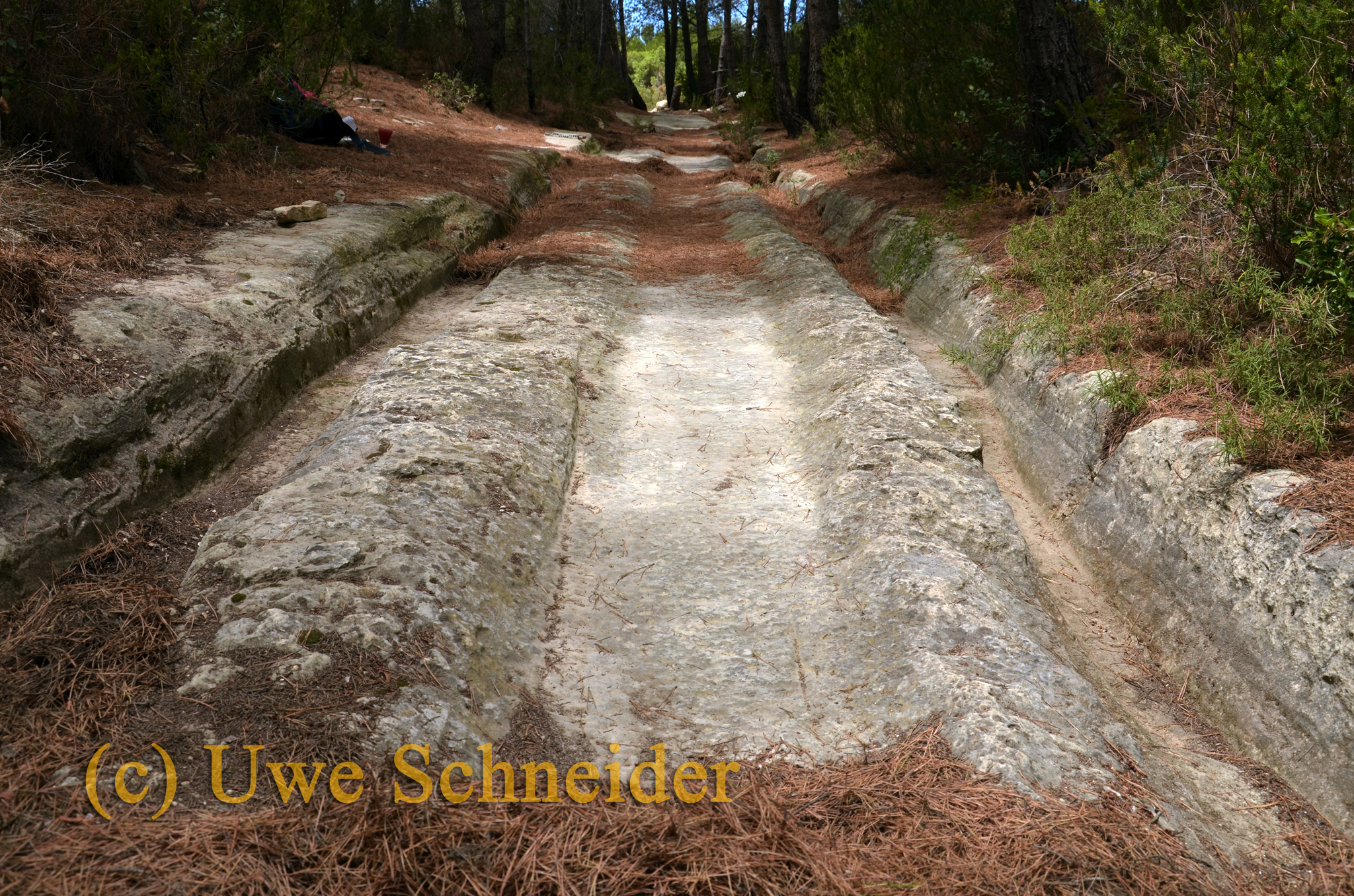
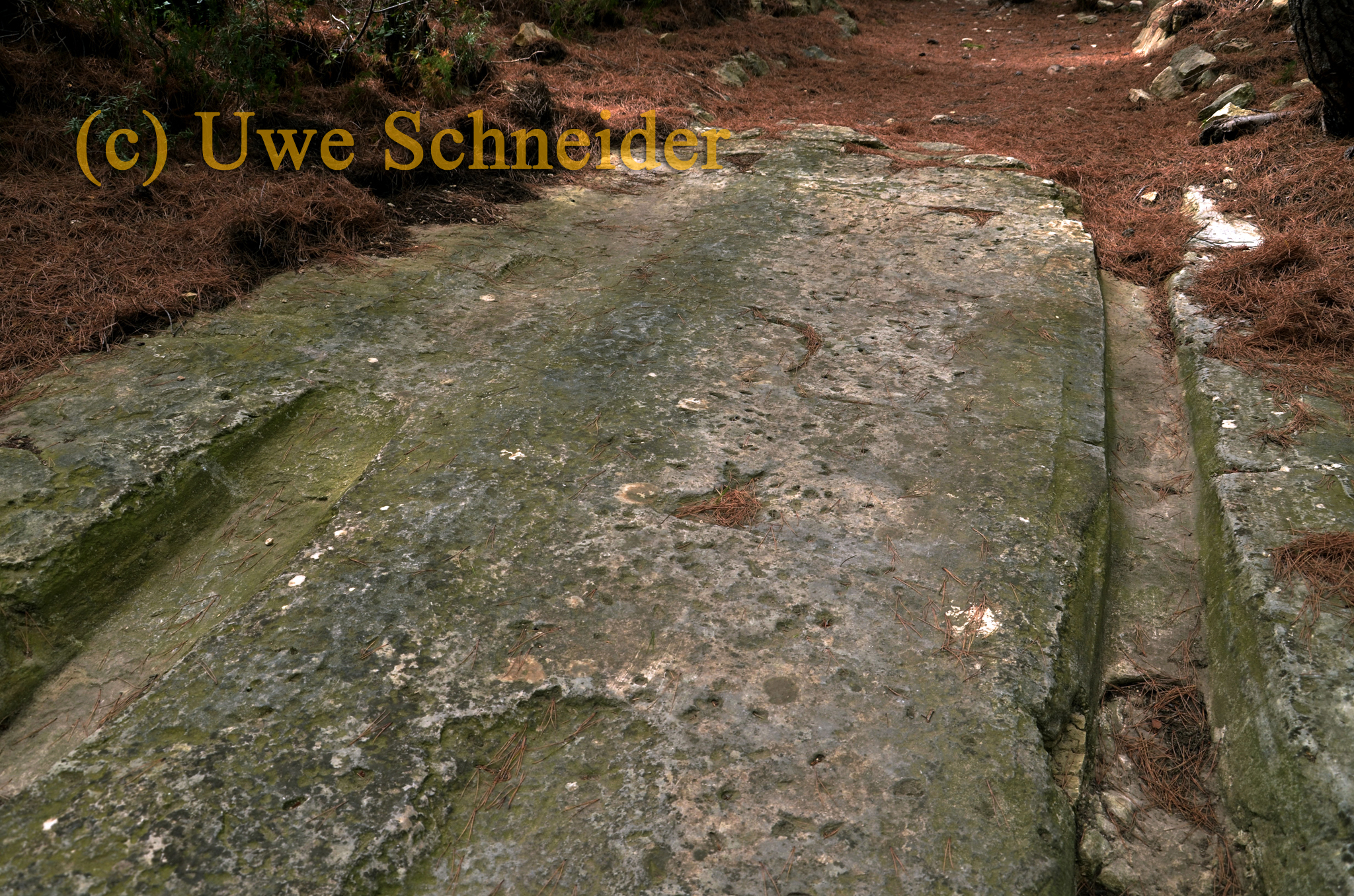
It should also be mentioned that these tracks, including grinding marks in the middle, are exactly similar of a track on Malta at Ta ‚San Gakbu!
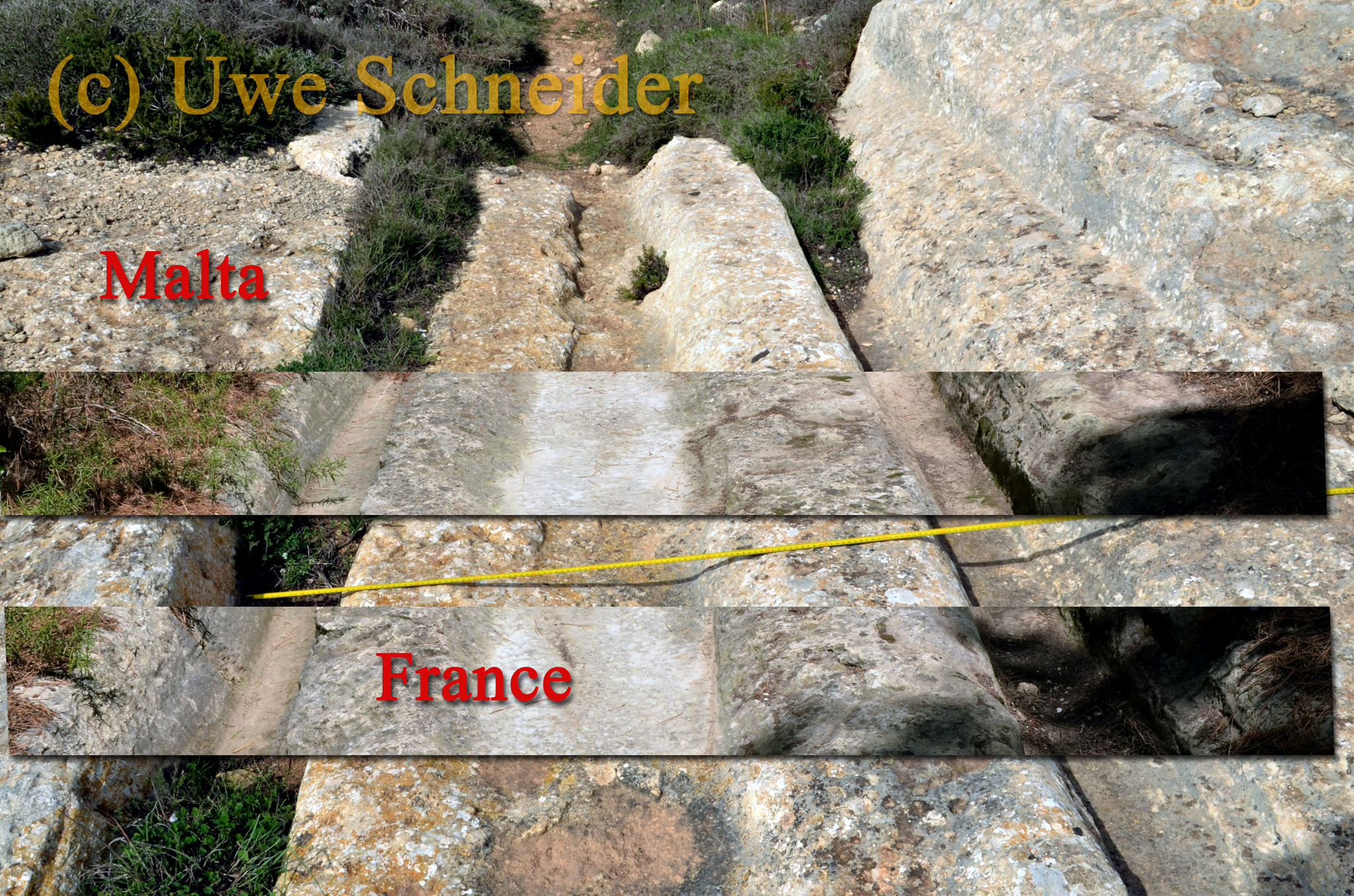
Let’s stay in Malta. On a sloping and slightly karstified limestone area near San Pawl tat-Tárga are some well-preserved rock tracks existing.
You can find places where one side of the track is cut up to 60 cm deep in the limestone and the other remains on the surface.
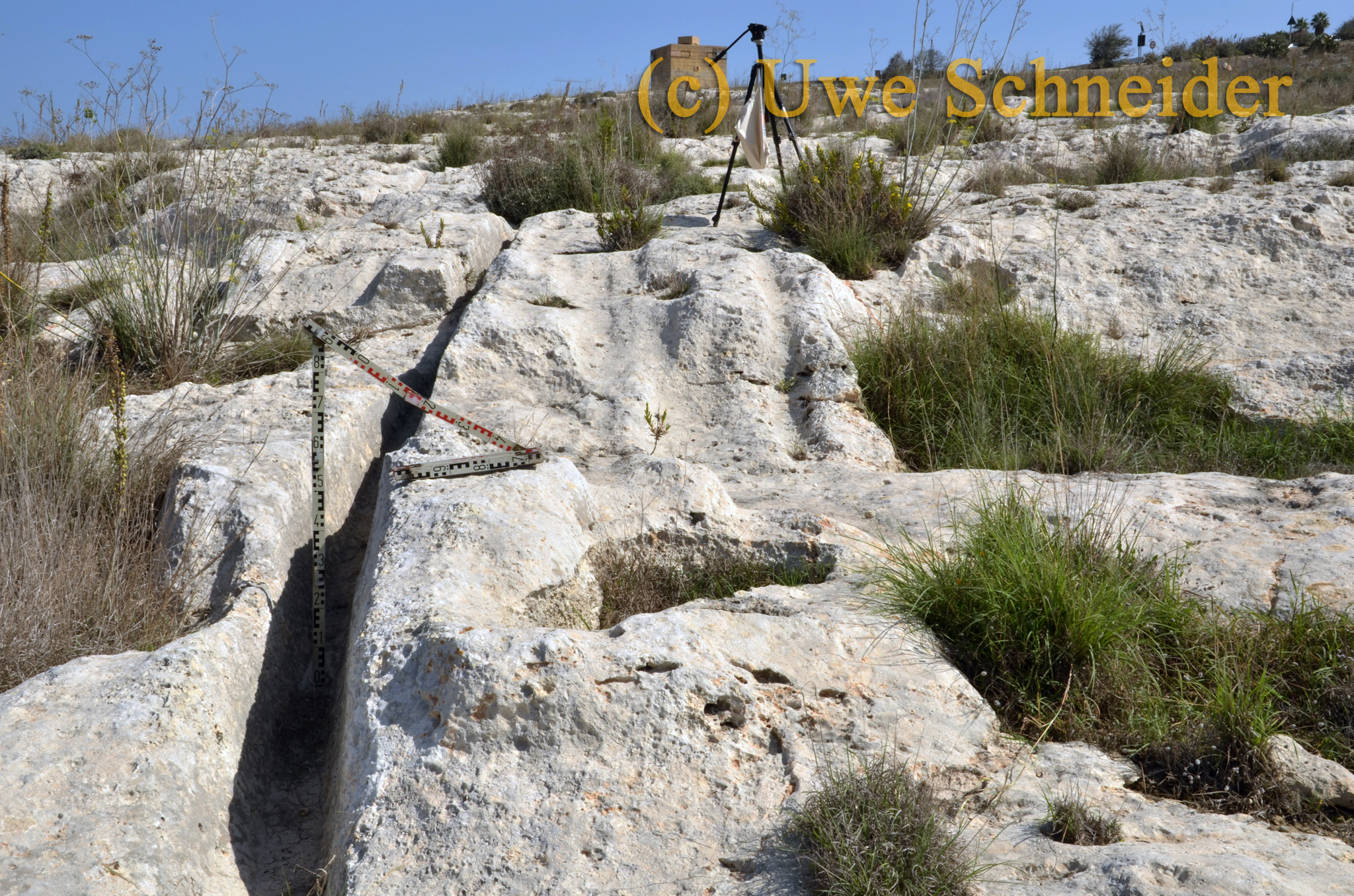
In the literature you can find an information, it could be a place for the ritual discharge of the load.
„In some special cases, a particularly shaped course, which is also created only by planned manual hand work shows …
One of the two channel bottoms suddenly appear on the surface.
A passing car suffers an inclination, which is incompatible with efficient transport. Presumably, the channel was designed so that a ritual automatic release of a load took place. “ (4)
I cannot embrace this attempted explanation, neither the suspected manual work nor the ritual dropping of a load, but the example clearly shows that all interested people, professionals or laymen, think about the limits of the imaginable.
Take look at these not uncommon bizarre characteristics of the tracks yourself, to see and feel that is a completely misunderstood phenomenon.
To complete the confusion, we find the phenomenon of the twin tracks, only on a few sections of the track.
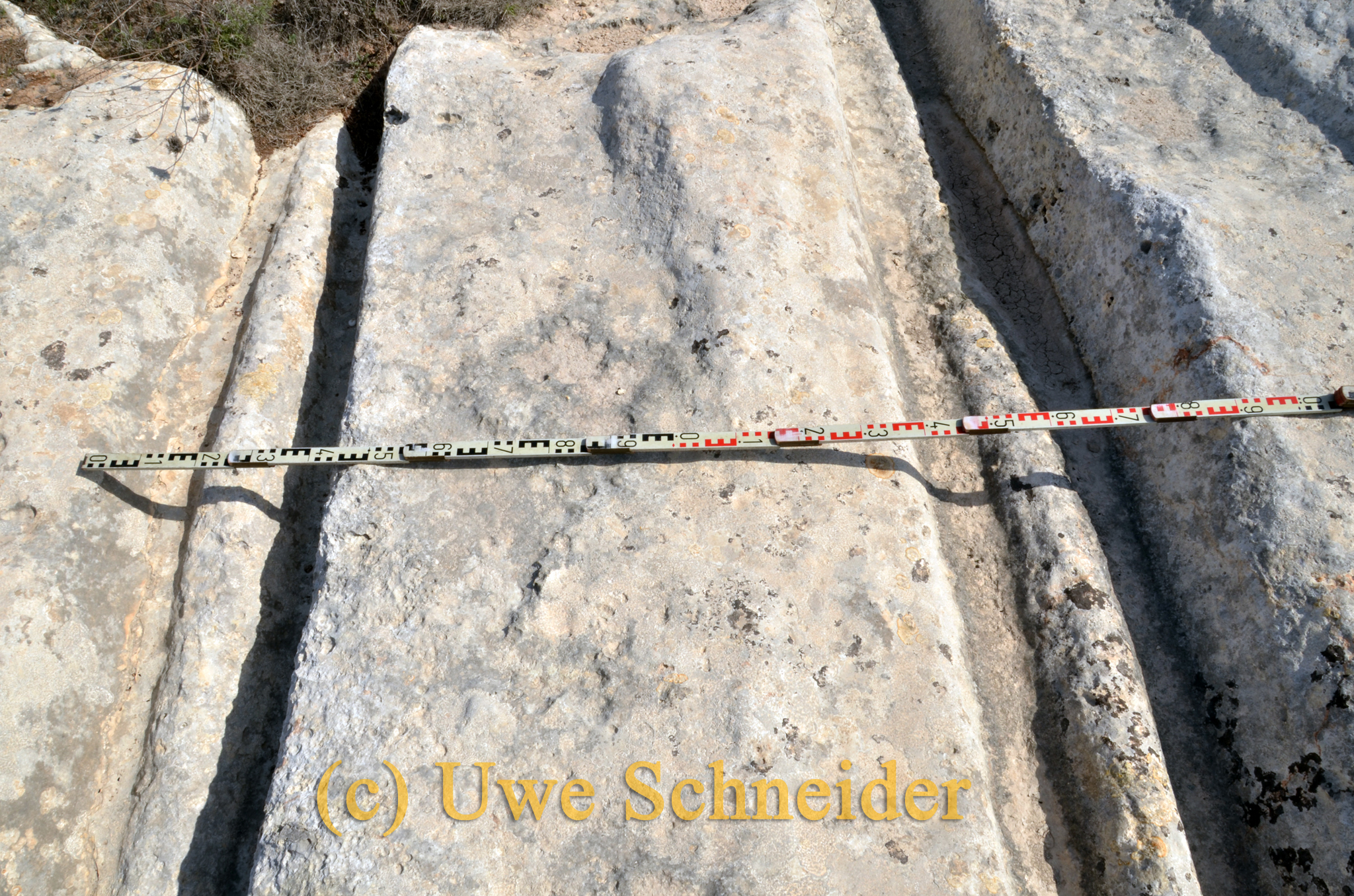
This phenomenon can also be found on the very impressive limestone plateau Castellar de Meca in Spain. At some sections such twin tracks can be found only partially.
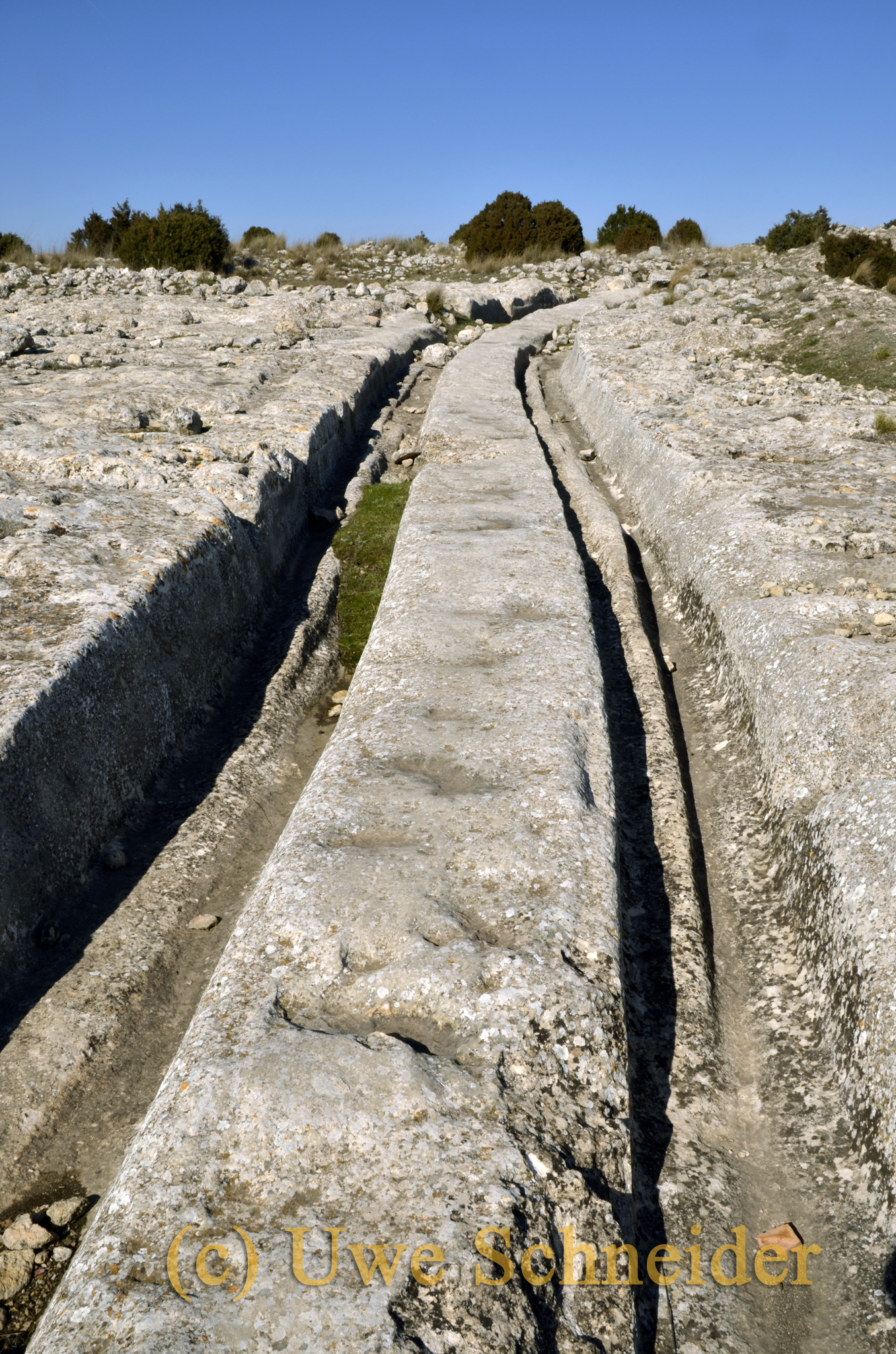
On this plateau the twin tracks appear, which is rarely seen, as planned creation. No seemingly senseless confusion as on most other cart-ruts areas, there is a clear route also with alternative sites for oncoming traffic, so it could be suspected anyway.
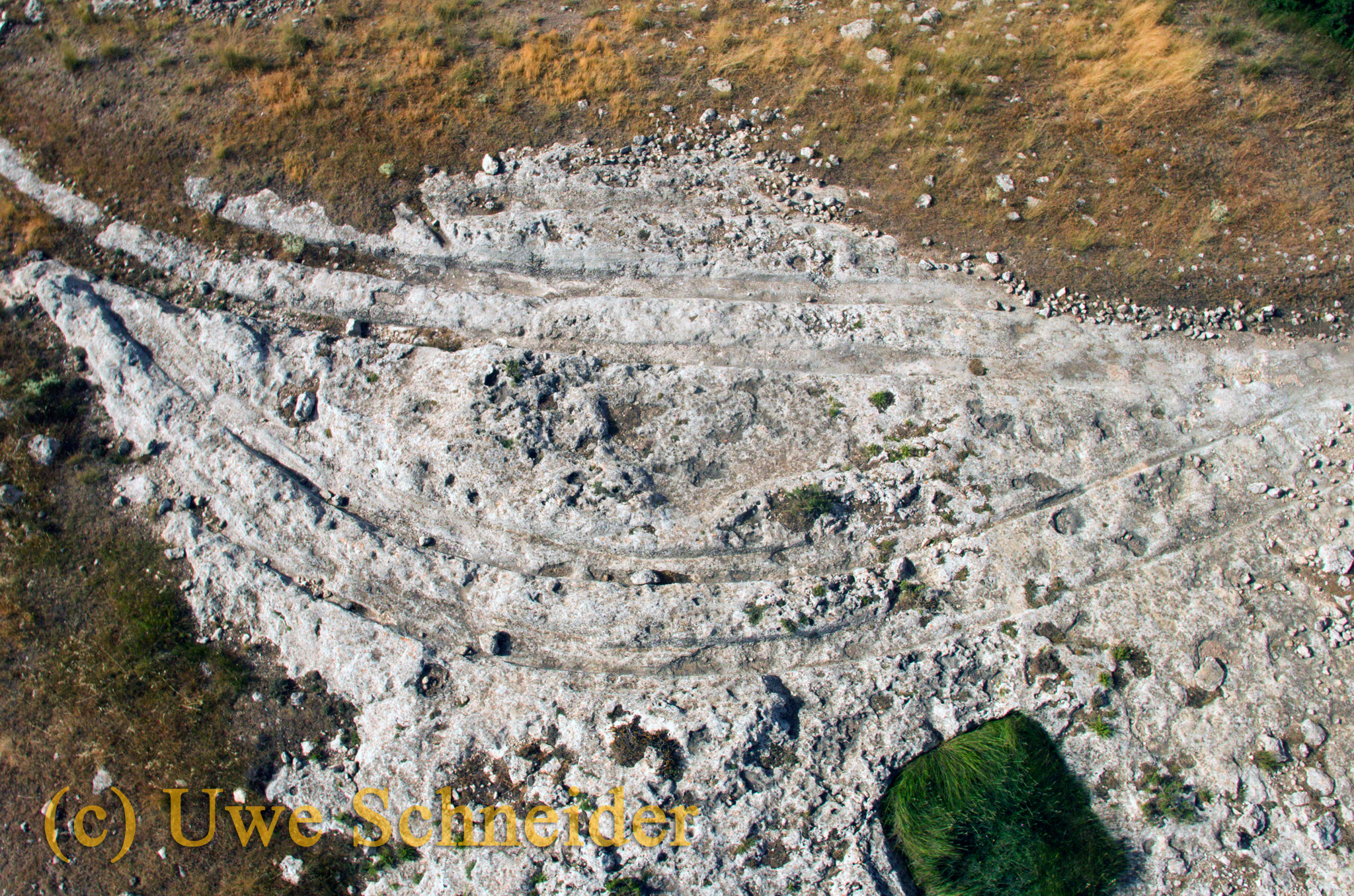 Alternative for oncoming traffic?
Alternative for oncoming traffic?
But in two places we can expect an unprecedented oddity. A track who is no longer used, is radically cut off by a younger track that lies a little bit deeper in the terrain. The degree of erosion is, from my point of view, the same.
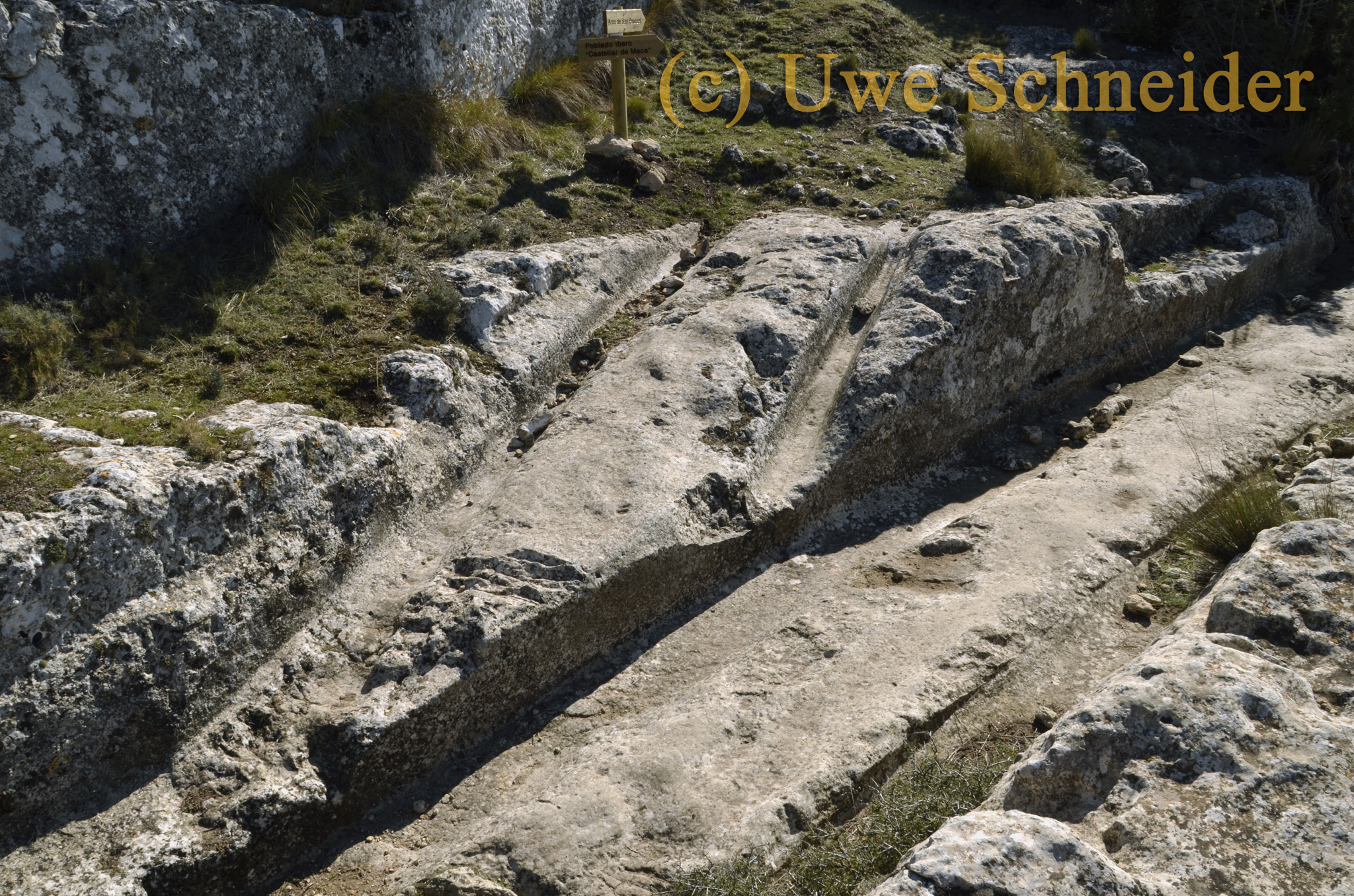
Not so in the second place! The older track here is located at a much higher level, at the highest point about 1.3 m above the „younger“ track, from which it has been cut off by smooth walls.
And the upper, older track has very strong traces of erosion, as if it were hundreds of thousands or even millions of years older!
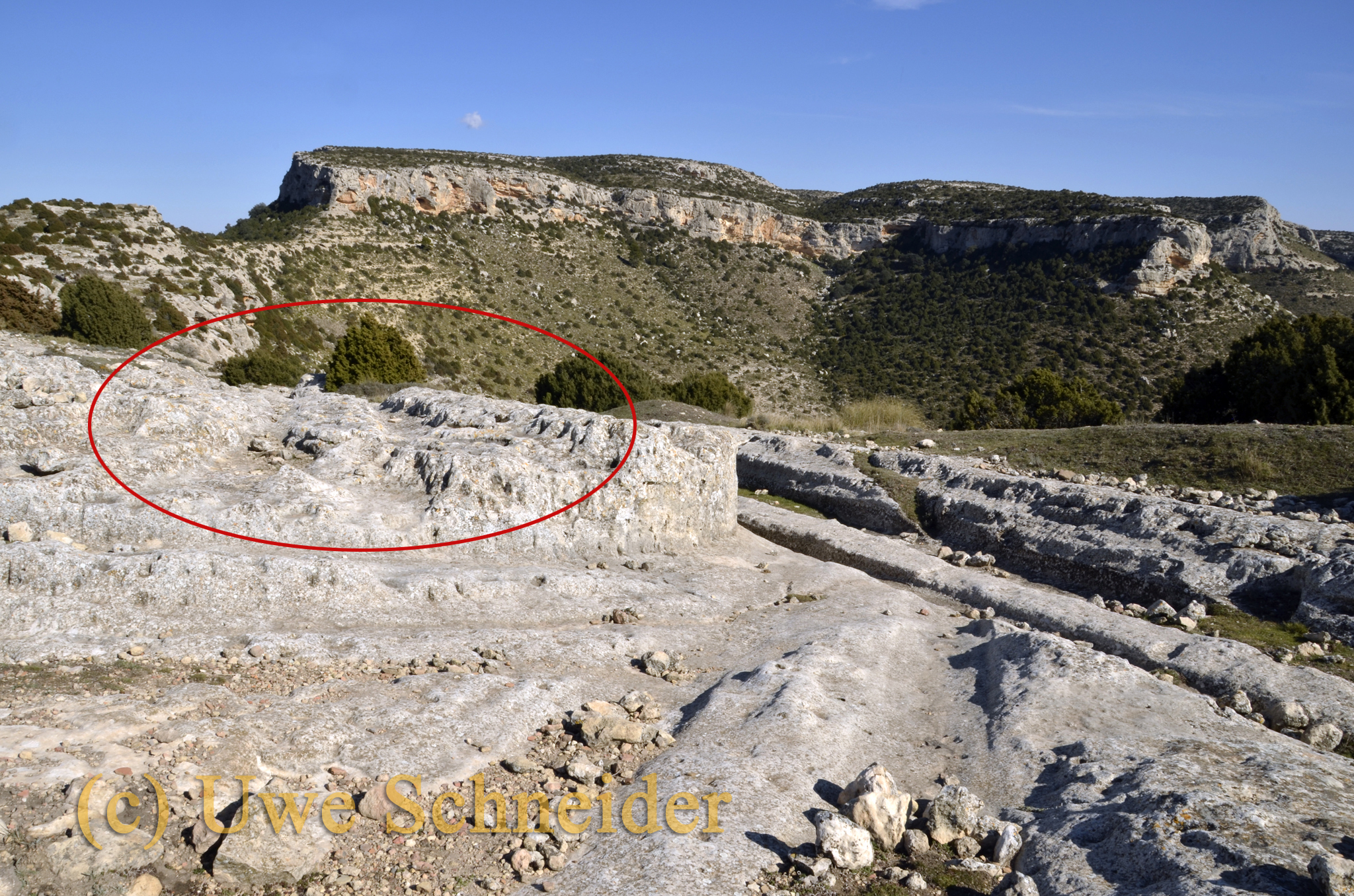 An older, heavily eroded trace
An older, heavily eroded trace
At the end of this chapter I would like to describe a wagon track near Nörten-Hardenberg in Germany. There, about 900 m north of the Rodetal, on the slope of a mountain, there is a track partially exposed in sandstone, which gives the impression that a car has never rumbled along here.
Smooth sidewalls and a track with millimeter fine lines do not make us think on ways in which iron-studded wheels may have left their mark for years.
Apart from the fact that the exposed section was relatively steep and very smooth, so that it was not possible to walk safely.
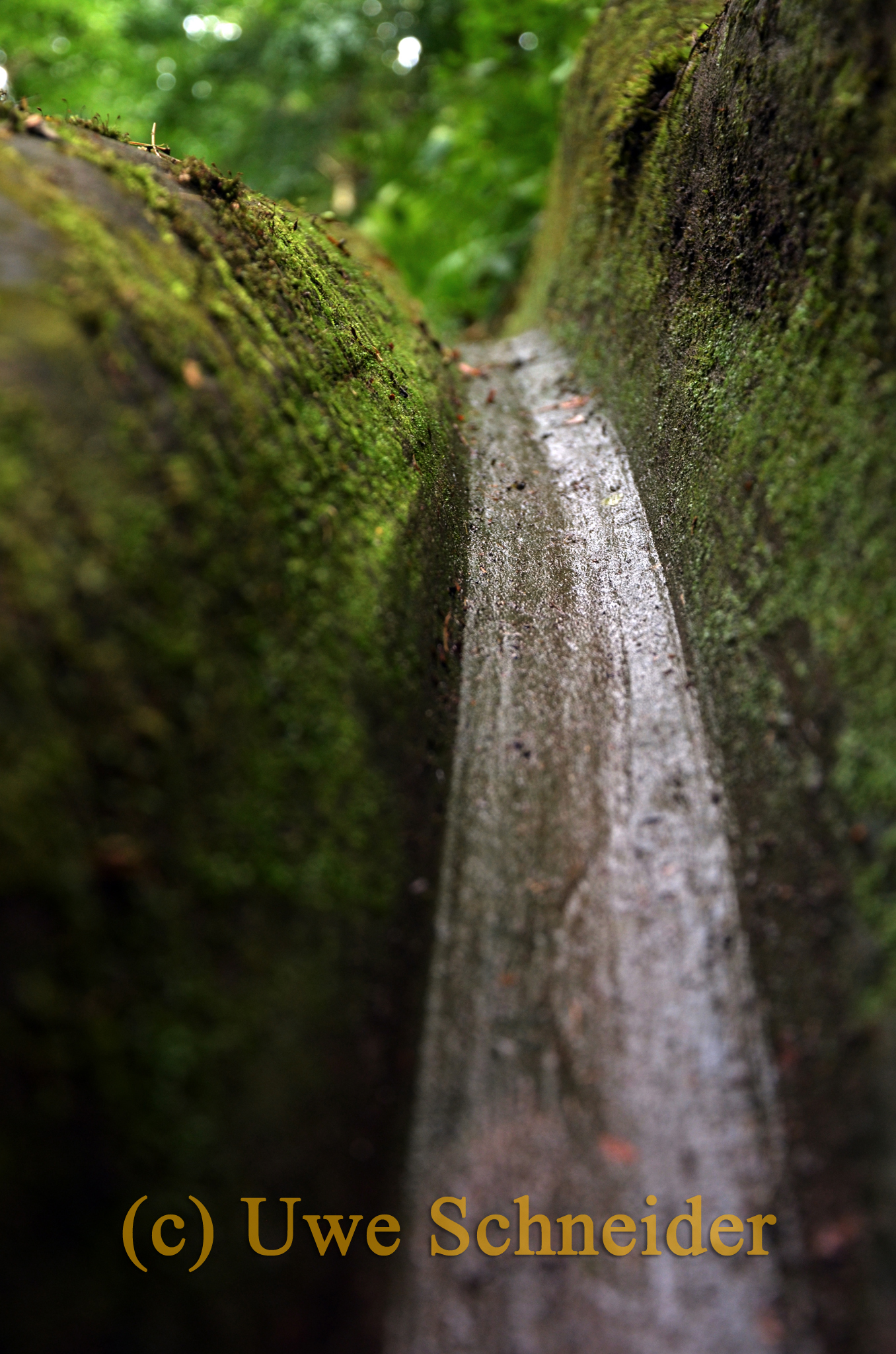
The properties mentioned here are not complete; Further information can be found at the respective sites mentioned on this website and in the next chapter.
4. Attempts to explain the origin of the traces
And that’s exactly how it still looks today, otherwise this website would probably not exist either.
As already shown in point 3 with a few examples, the rock tracks have diverse and sometimes very bizarre properties that are very hard on common sense. Nothing seems to make any sense. The many mosaic stones form no picture.
The traces, the formation of which I can most easily imagine, are in western Anatolia and in Cappadocia. In these regions there are huge deposits of tuff, in which an incredible number of vehicle tracks can be found.
There it definitely doesn’t look like careful and well thought-out traffic route planning, but rather as if off-road enthusiasts had plowed through the formerly loose tuff deposits with their jeeps or with other, all-terrain vehicles.
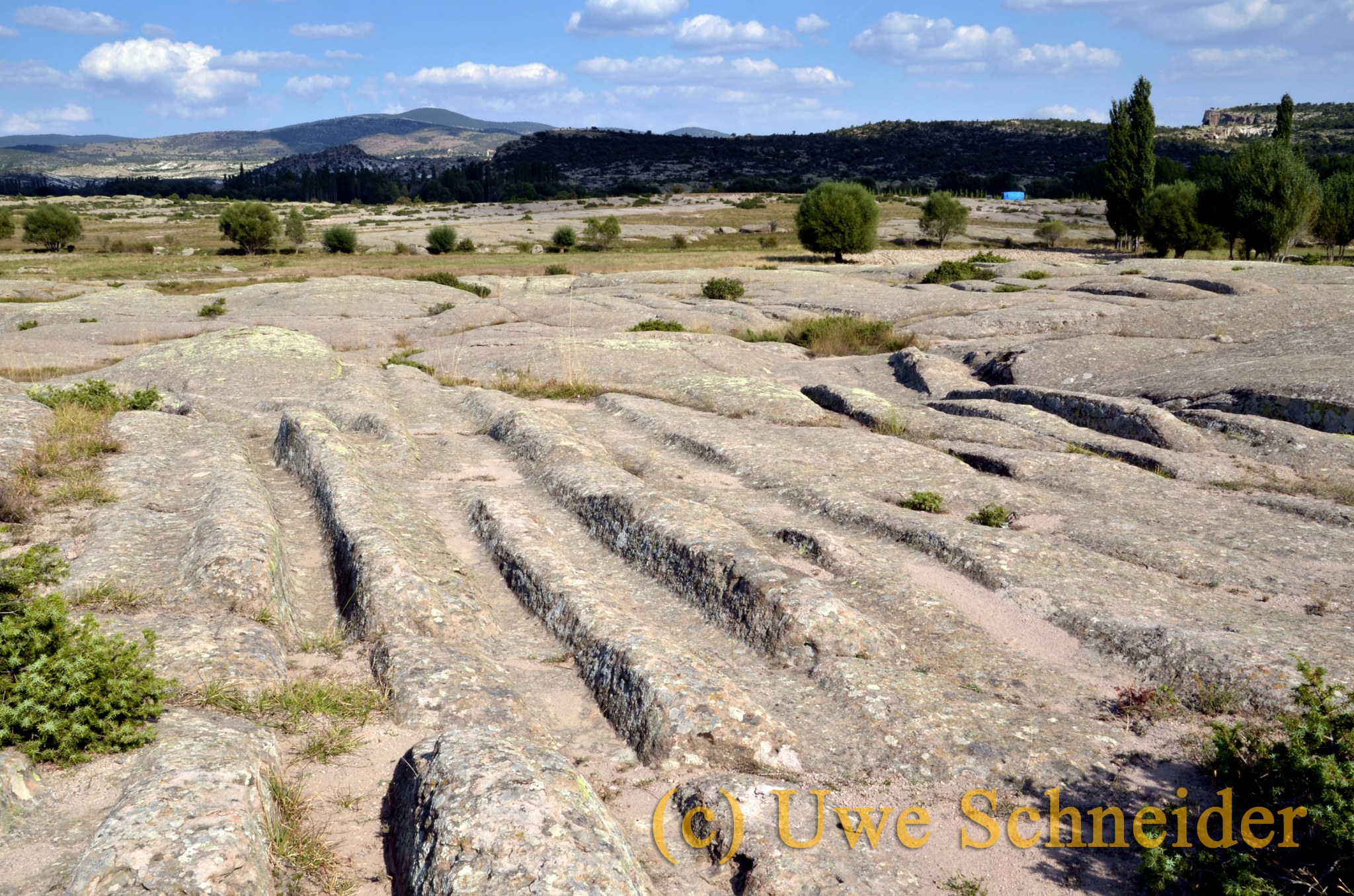
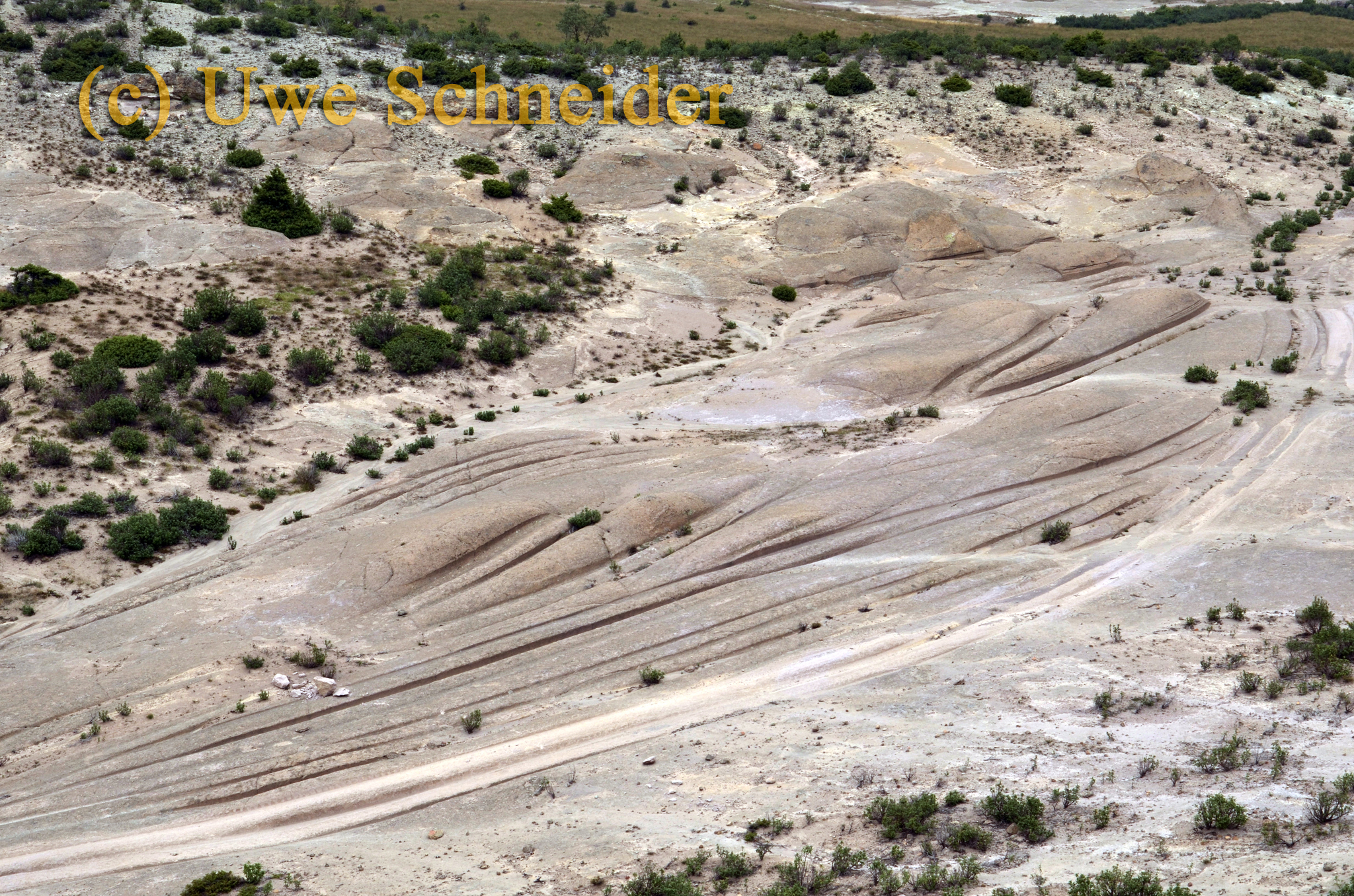
I do not claim that these traces were created in this way, but this thought is inevitable when you see these traces on site!
The resulting traces gradually solidified, were covered by deposits and were partially uncovered over time.
One part is heavily eroded, hardly any, other areas are still covered with sediments, but a large part is easy to see and wonderfully preserved.
The problem with this possible scenario is the age of the tuff deposits.
The former volcanoes in these regions were active millions of years ago!
This dating to the origin of the traces there is of course strong theoretical,
but we cannot choose the facts, the appearance of these Anatolian traces
is as it is!
On the side, it should be noted that fossilized dinosaur tracks in limestone, like here in the Cevennes in southern France, are no worse preserved than many cart ruts.
I have often seen fragments of cart ruts in limestone that have almost been removed by erosion.

In Malta, at Ta ’San Gakbu (but also in other places), a trail leads over a cliff into the void, followed by a valley that is approx. 70 m deep and approx. 700 m wide. What are the periods here ?
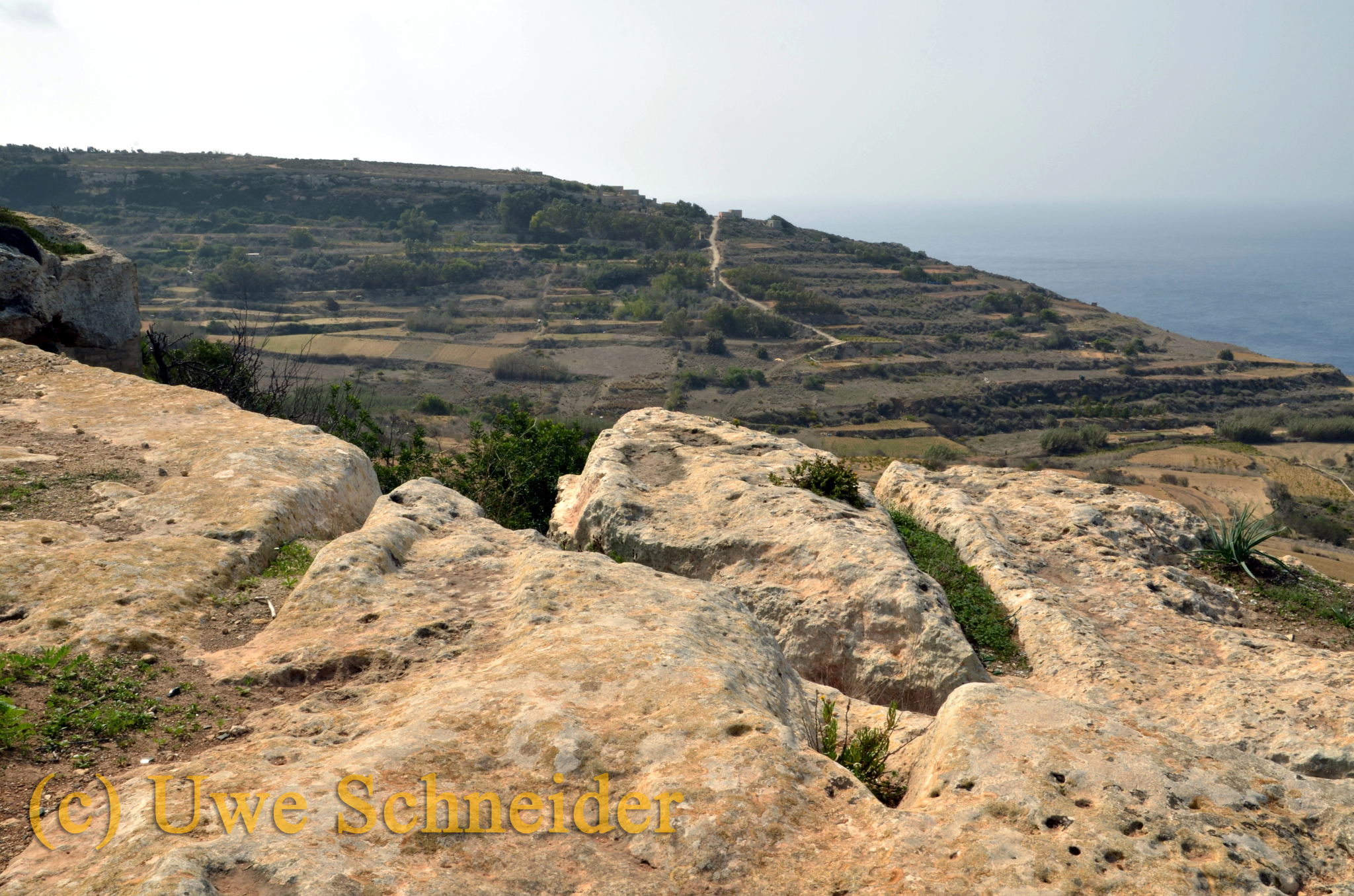
There are also traces in Malta that disappear into the sea.
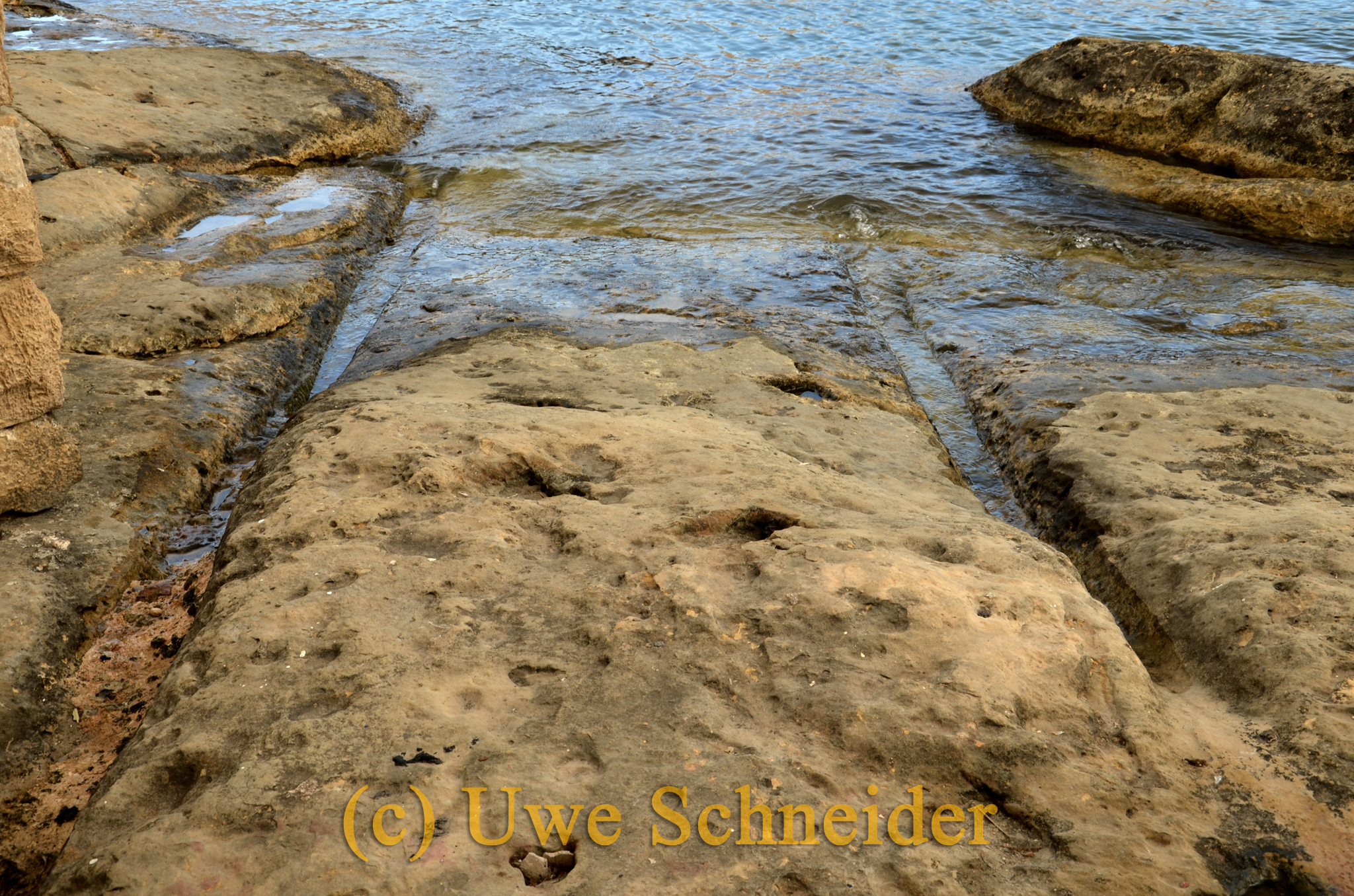
And here in Spain, too, on a sandstone plateau near Caspe, the traces vanish like in Malta.
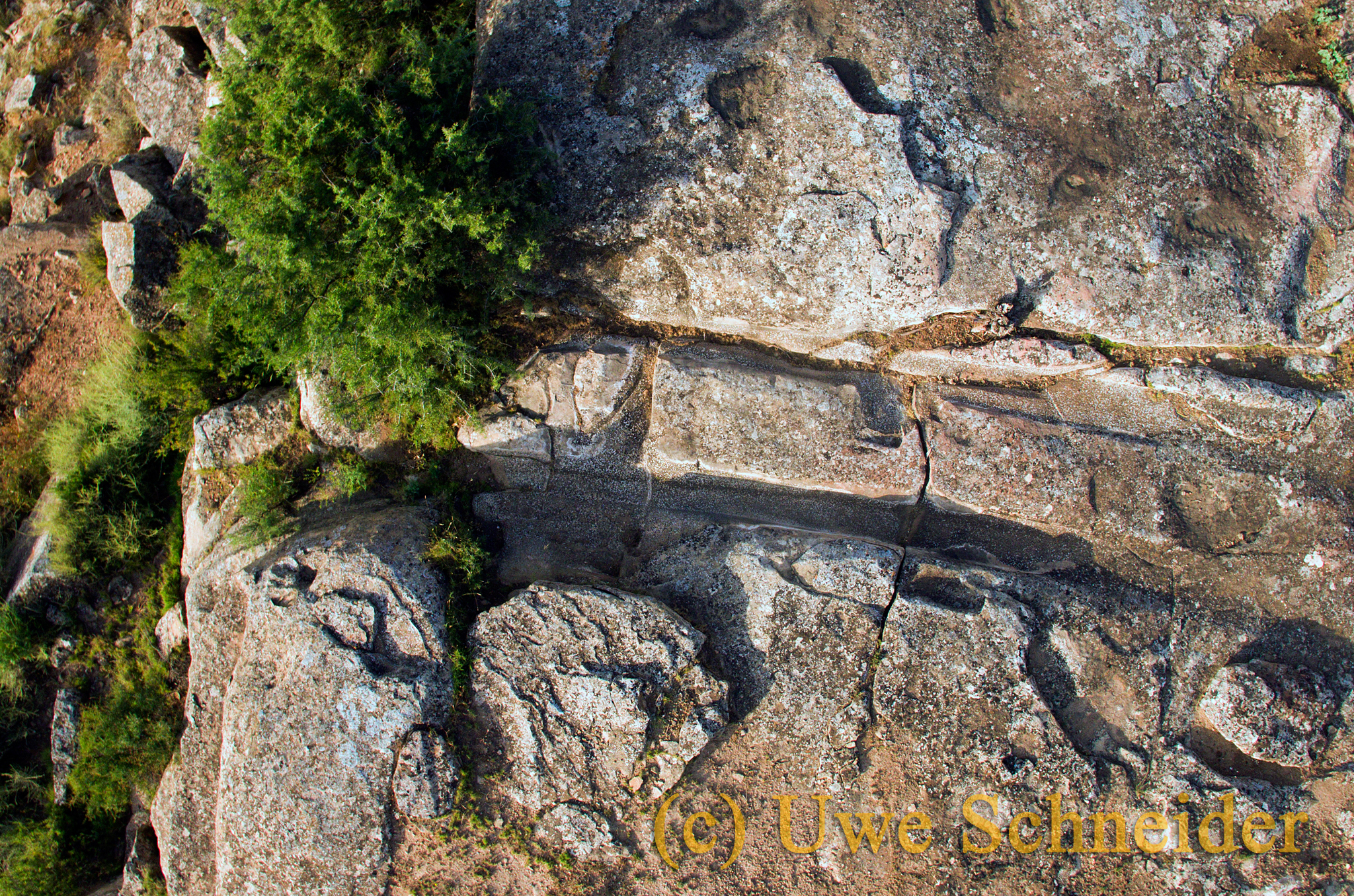
In October 2018, another trip took me to Sicily.
And here in Agrigento, too, there are some places where the traces over the cliff edge disappear into nothing.
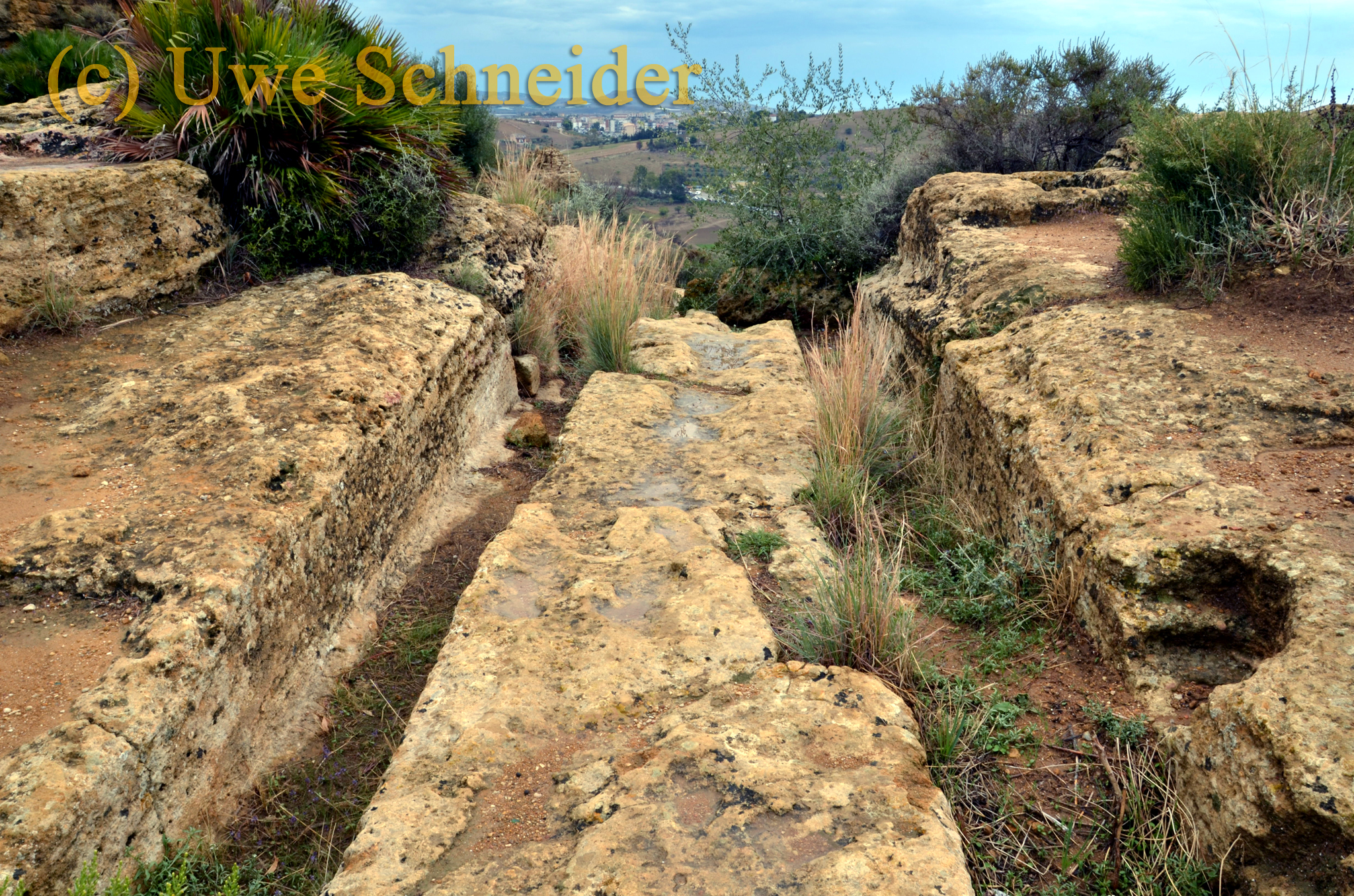 Track at Tempio Di Giunone
Track at Tempio Di Giunone
And here are some other places where erosion has completely removed deeper sections of the trail.
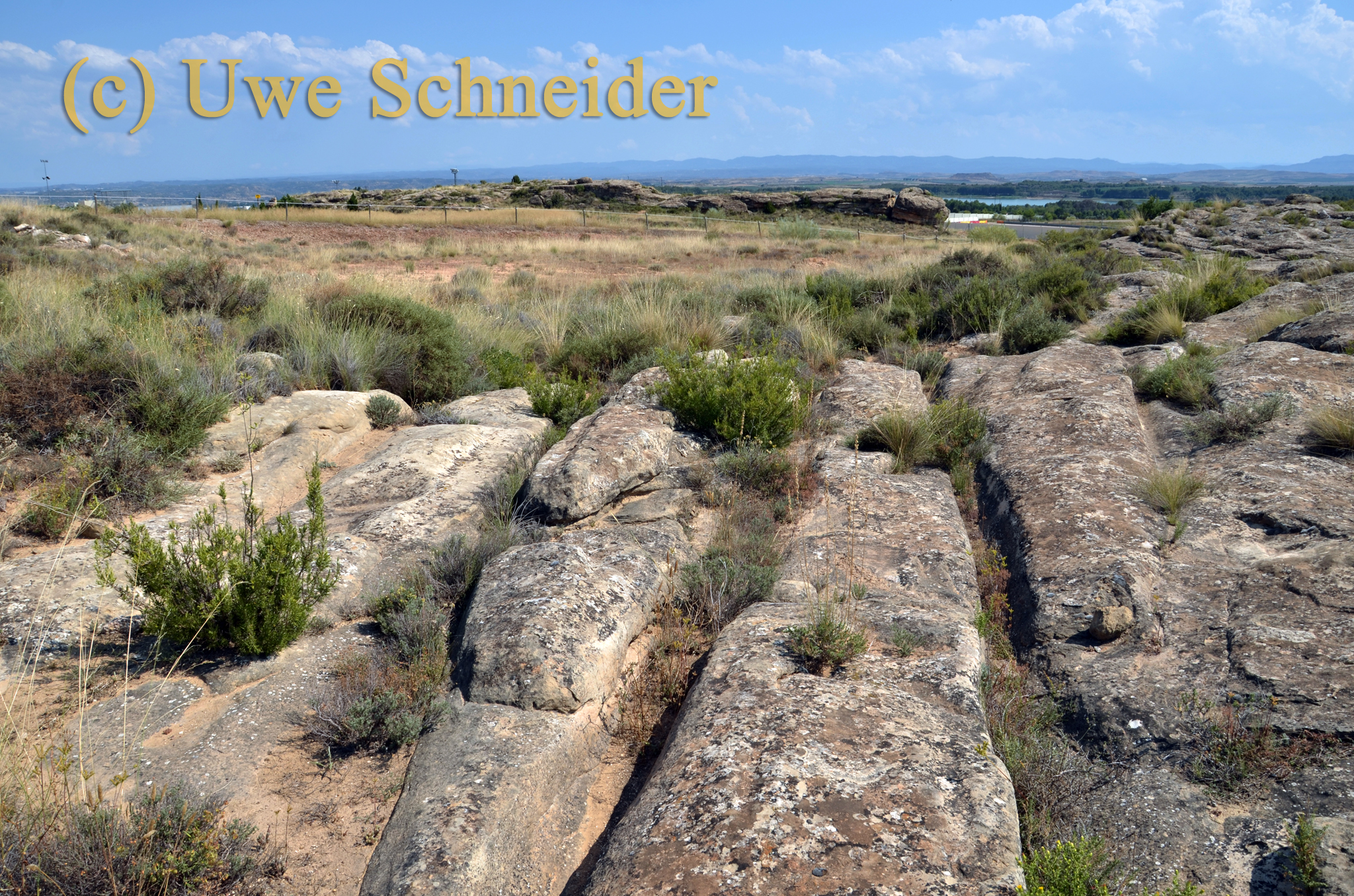
Traces can be found on a sandstone cliff near Alcañiz (Spain), the further course of which to the north and south has been removed by erosion. Here is the southern edge.
The many cliffs could be the remains of a plateau.
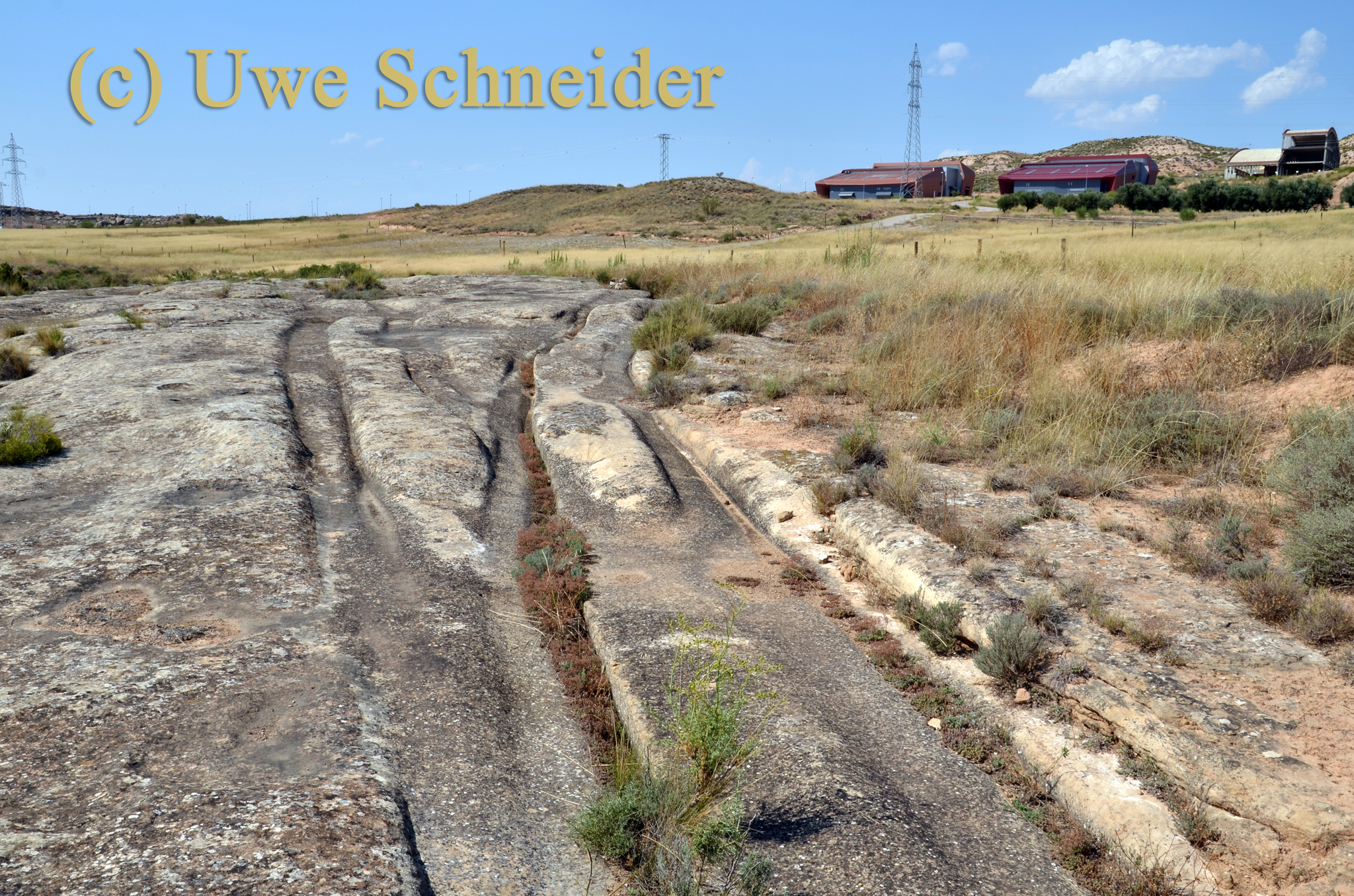
Here is the northern edge of the sandstone cliff. The tracks lead to nothing.
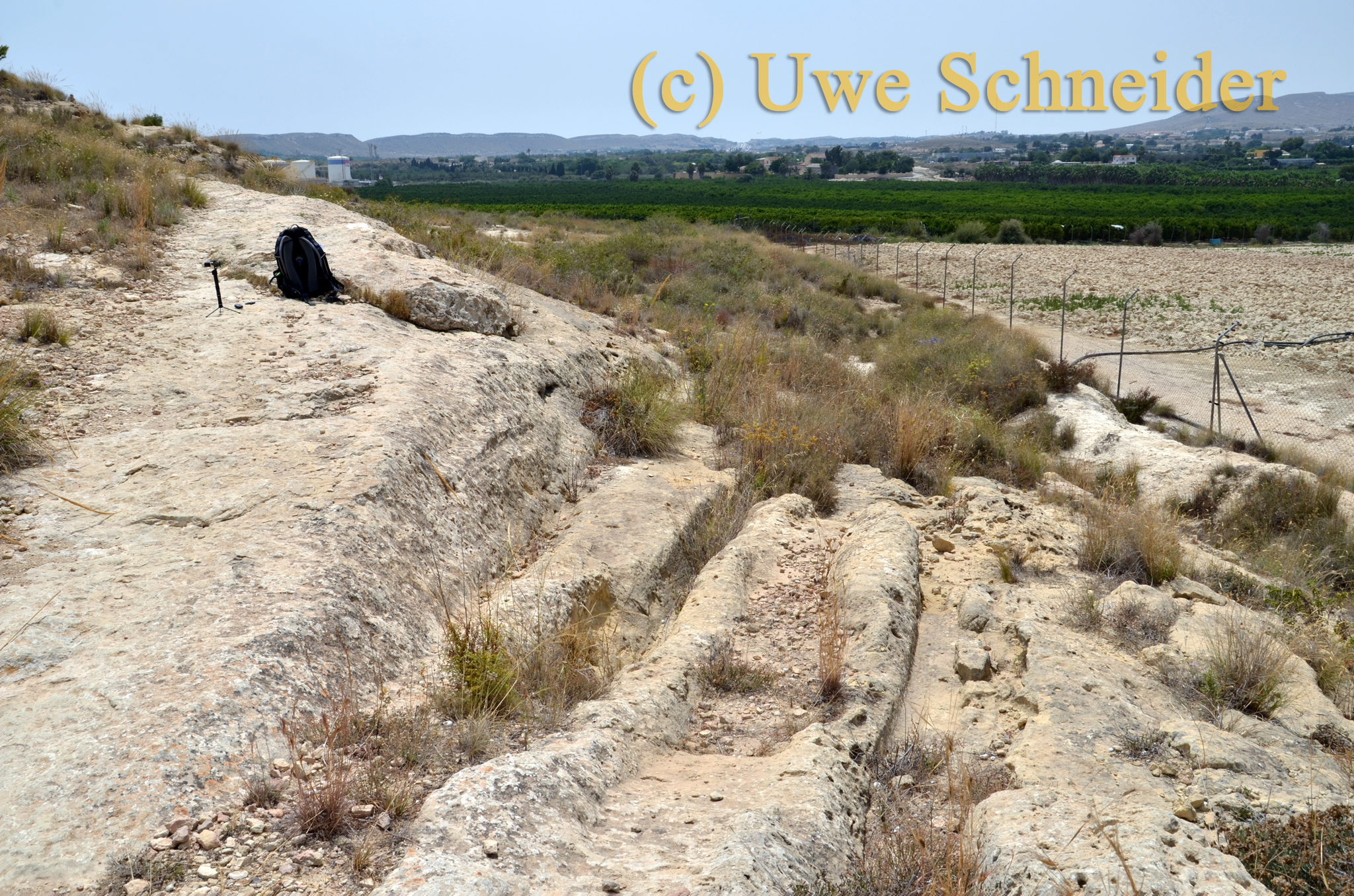
One of several places near Alicante (Spain) where traces of nothing disappear from a sandstone plateau. The erosion has done a great job.
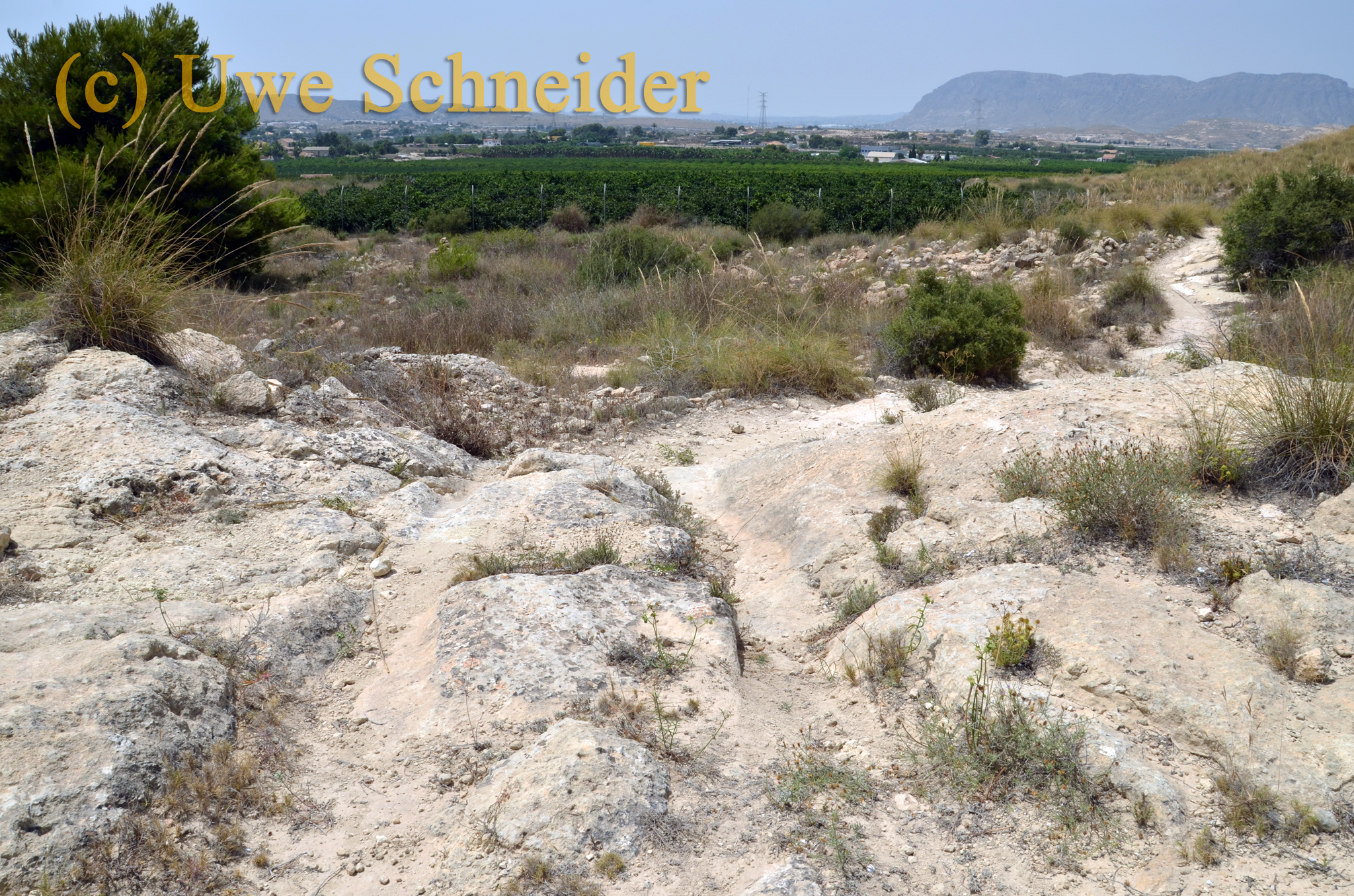
The same can be seen here. What time periods are we talking about?
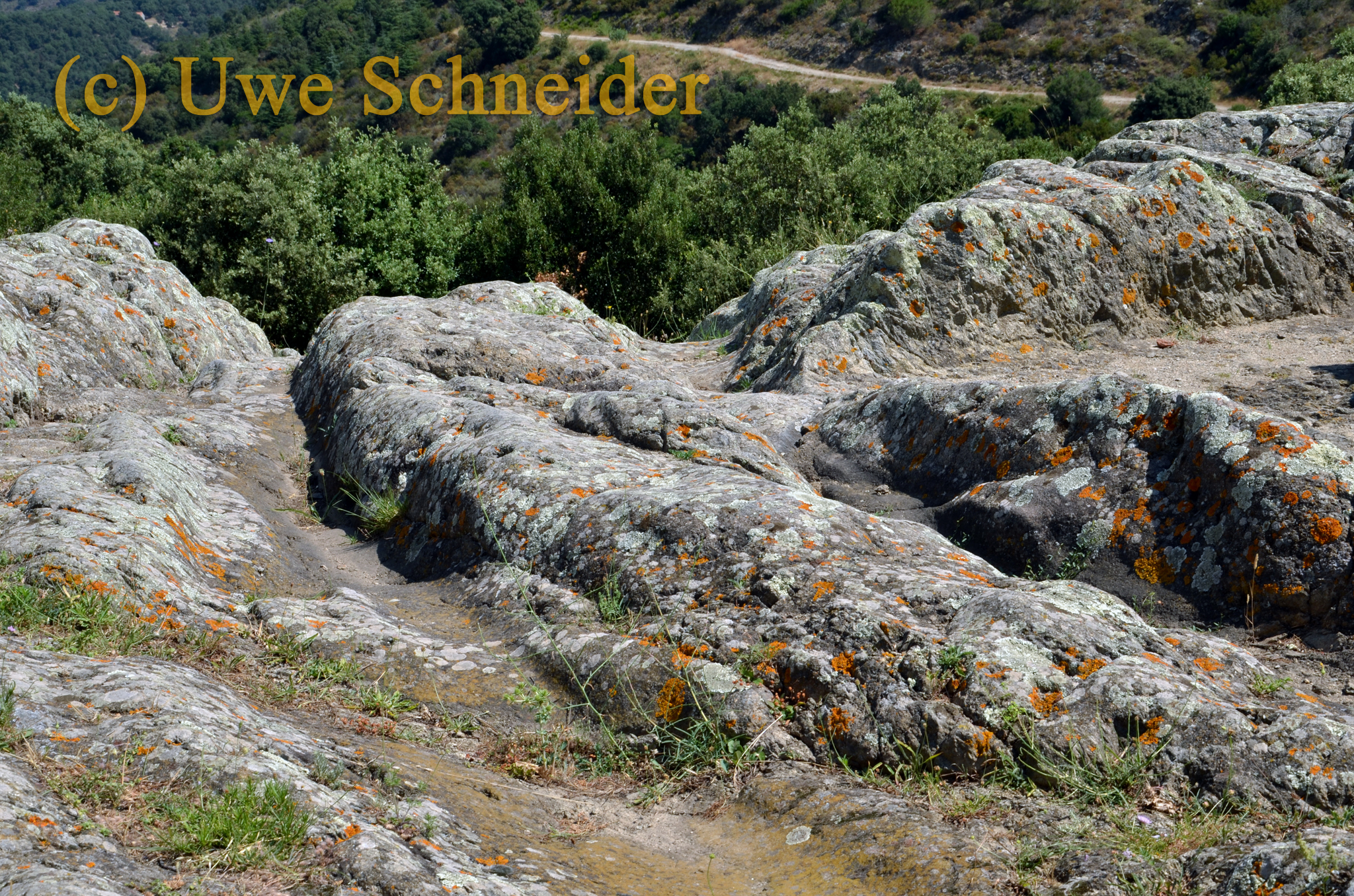
Here too, at the Archéologique du Panissars site near Le Perthus in the French Pyrenees, the trail disappears into nothing. The rock is probably gneiss. The idea arises that coltypin is not wrong.
In Syracuse, where Archimedes is said to have found his final resting place, the limestone cliffs and cart ruts were cut off by the creation of necropolises.
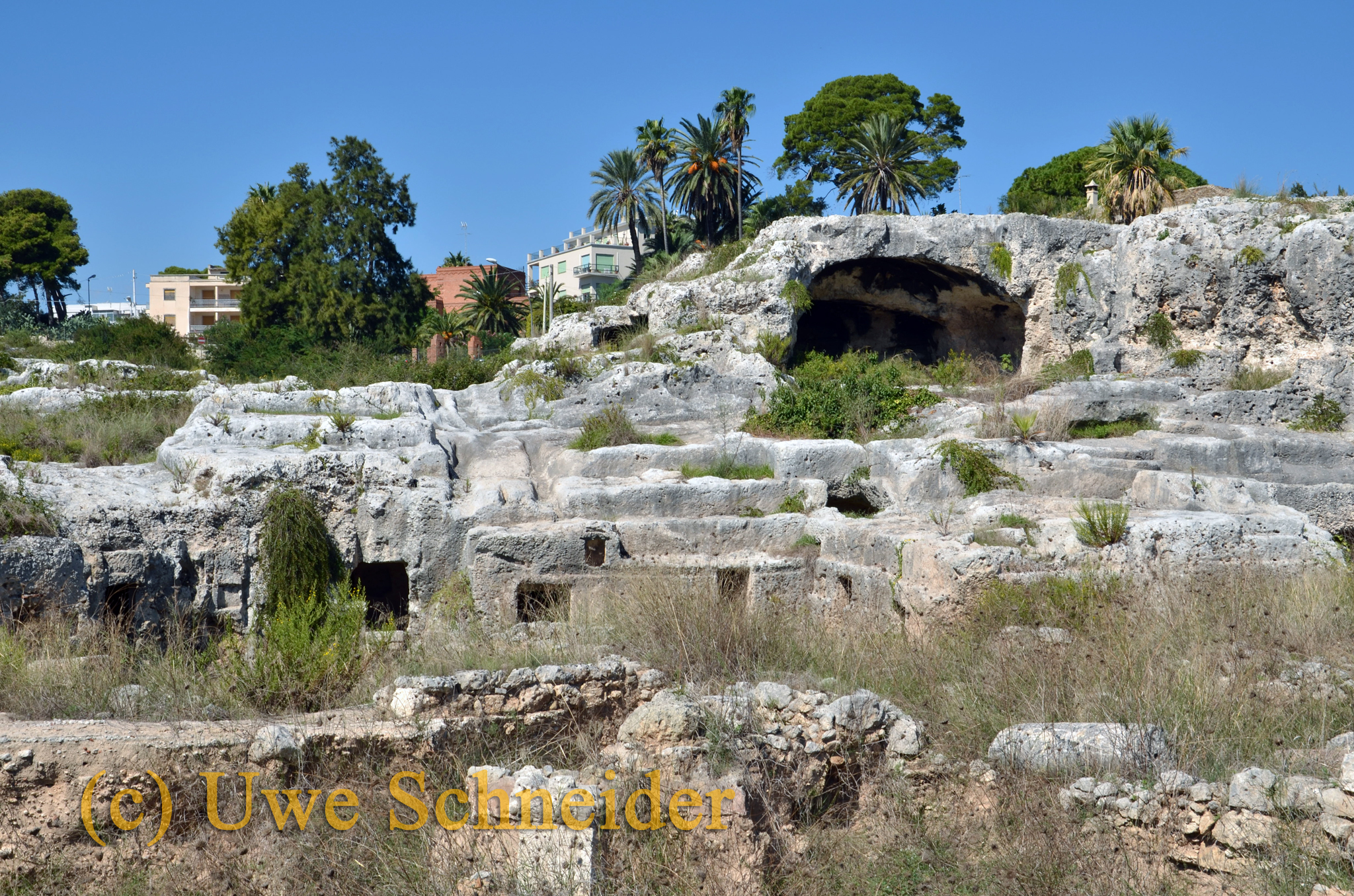
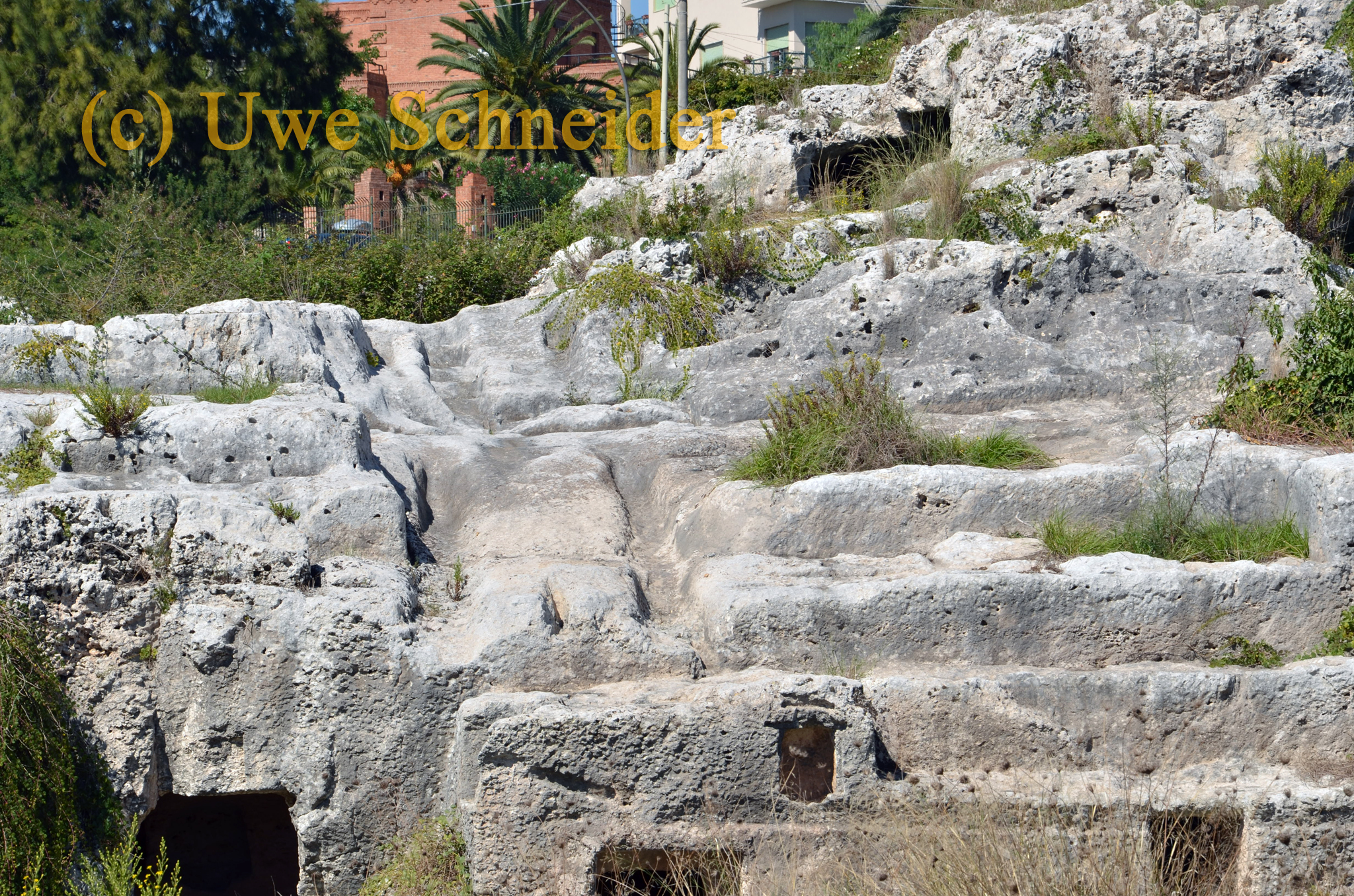
Clipped traces by creating the necropolis. I suspect that Archimedes‘ thoughts have already made their mark. Are there references to this in his writings?
I do not wish for one or the other scenario, I am just curious and would have no problem with it if traditional ideas turn out to be untrue.
But I wouldn’t have a problem with it if they really were ox carts from the time of the Romans. This is what archeology explains to us; the tracks would come from heavily loaded bullock carts carrying stones.
And here we come back to the properties of the wagon tracks, namely a feature that I have briefly mentioned. The traces of the draft animals are simply missing!
I have never seen anything like it in western Anatolia. Not the slightest hint of tread marks and that with the relatively soft tuff, should it really have been hardened when the cart ruts were created.
Traces can already be found, but there are others. So e.g. Grinding marks in the middle, as if something were hanging from the vehicle.
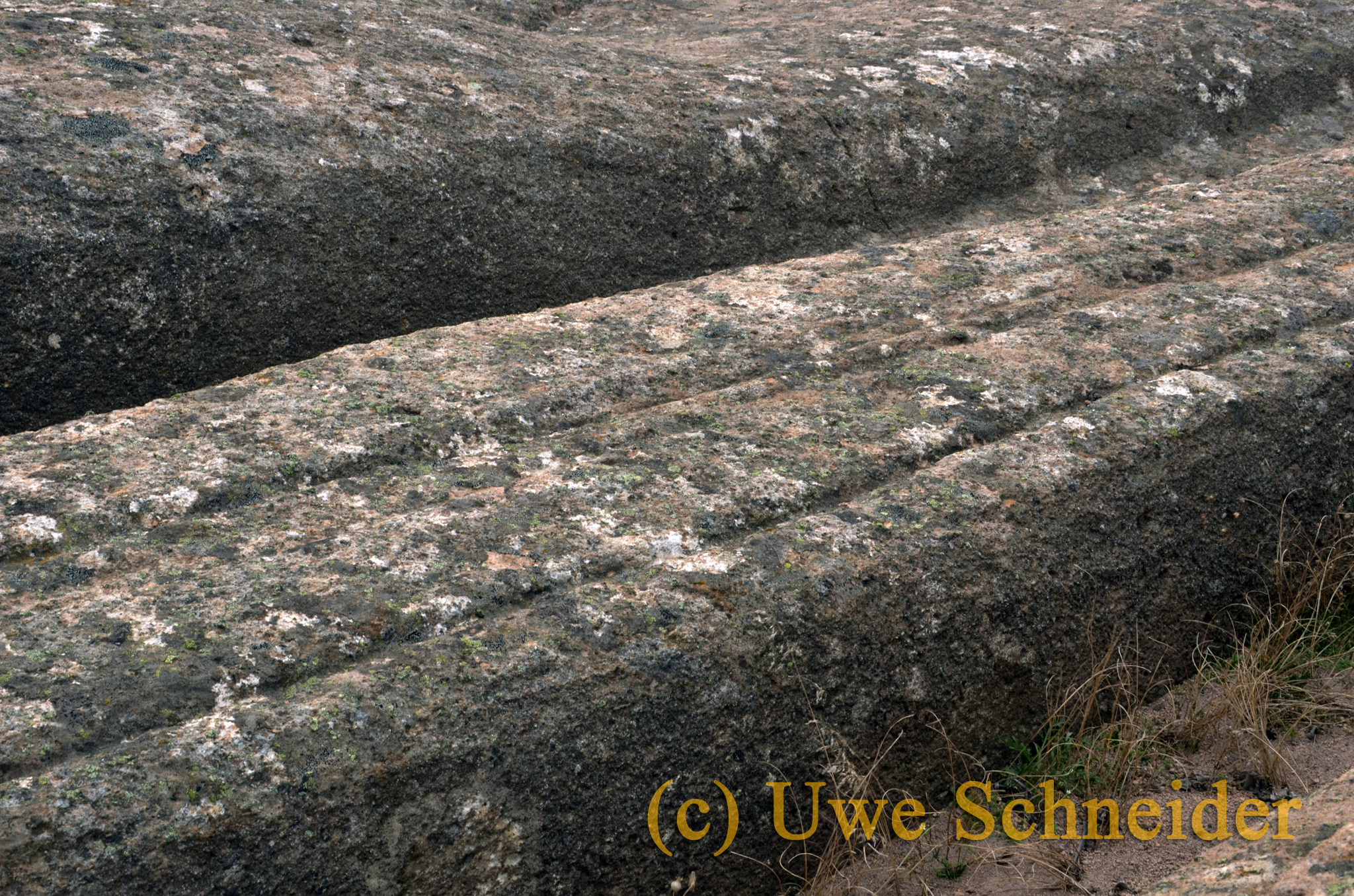
On the left and right of the vehicle tracks there are often large grinding tracks in the tuff, as if the body or the load of the vehicle had protruded far beyond the track width and left the not too small scratches in the still loose tuff.
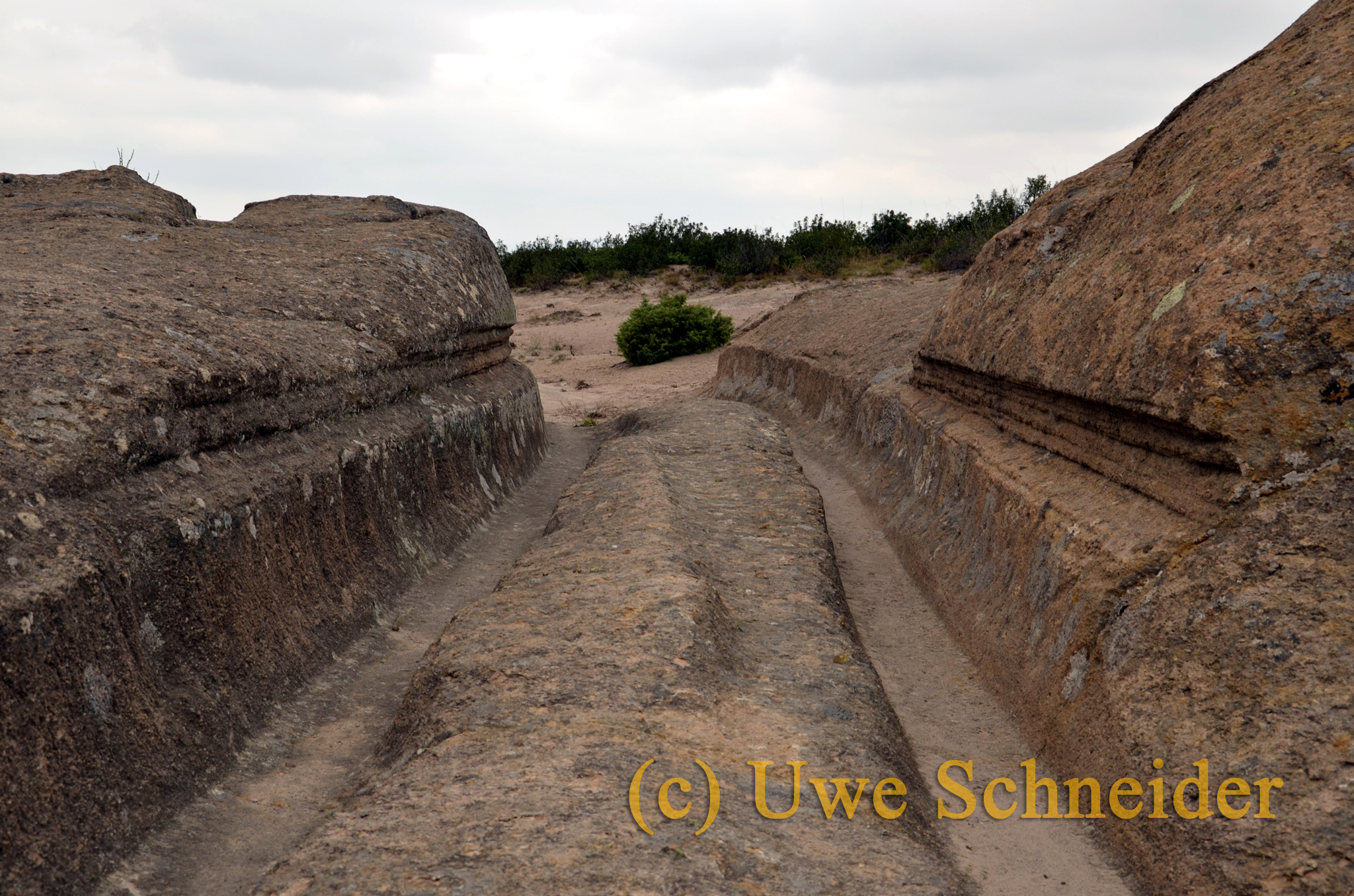
And there is another important point that prevents an emergence in e.g. Roman times speaks: The terrain of these tuff deposits is very eroded and jagged. I wouldn’t think of driving around there, any vehicle would break.
Even the idea of an archaeologist that it could have been heavily loaded sledges in winter does not work in practice.
We can still imagine offroad enthusiasts in loose tuff, but what about similarly chaotic car tracks in limestone?
Again we find no signs of meaningful traffic routes (with the exception of Castellar de Meca), instead there are many parallel and occasionally overlapping lanes, actually a single chaos, this time clearly visible e.g. on Malta’s No. 1 marshalling yard, Clapham Junction, and in Sardinia, here on the Su Crucifissu Mannu limestone plain.
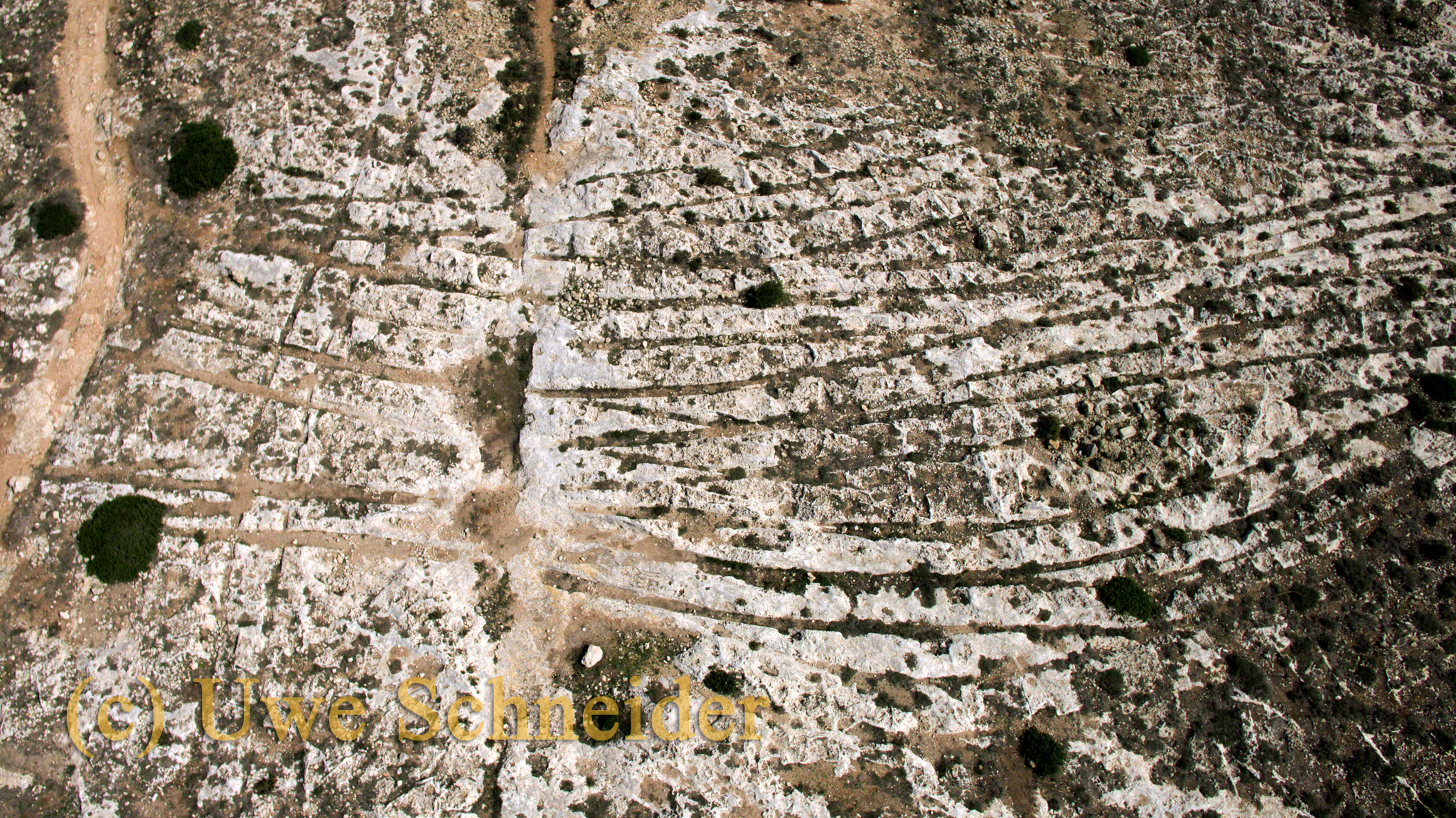
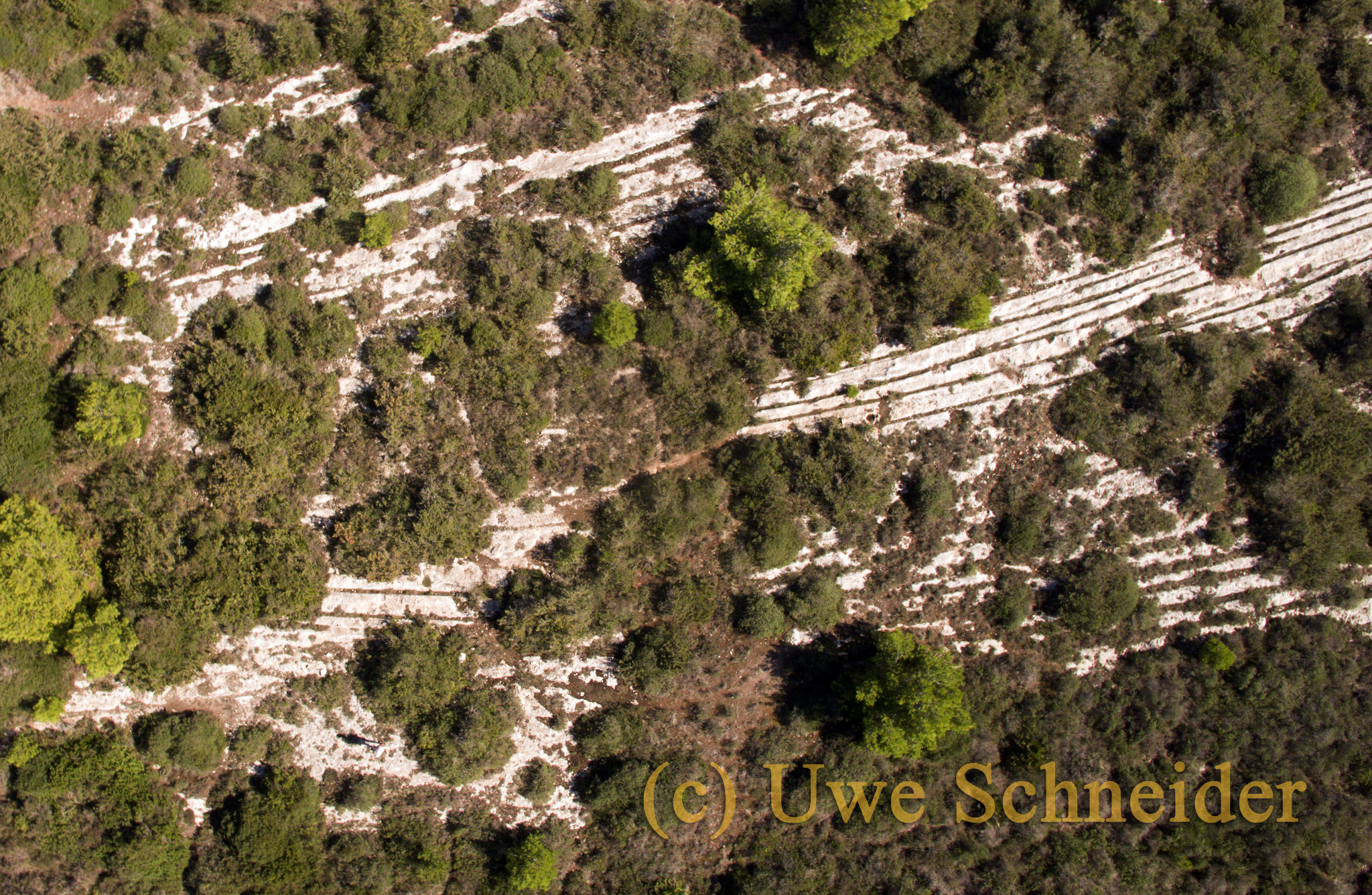
At both locations there are also some grave sites that were created after the tracks appeared, because they often interrupt their course.
The big questions now are how and when the cart ruts were created in the limestone. With very few exceptions, e.g. at Ta ’San Gakbu on Malta, we again find no evidence of traces of draft animals.
Even here, I wouldn’t think they came from draft animals.
We can often observe that the rock tracks run smoothly through the limestone. This is particularly evident at the Castellar de Meca in Spain.
There are no signs of chisel traces, nor is it really conceivable that these traces are caused by gradual driving through e.g. iron-studded wheels have arisen. Even the ascent from the plain to the rocky plateau shows very clearly (especially in the tight curve, which is approx. 3 m deep!) many horizontal grinding marks, which can actually be found everywhere where the cart ruts lead through incisions in the rock.
If you see these smooth traces of grinding, the thought immediately arises that the rock was not yet hardened during the formation of the traces.
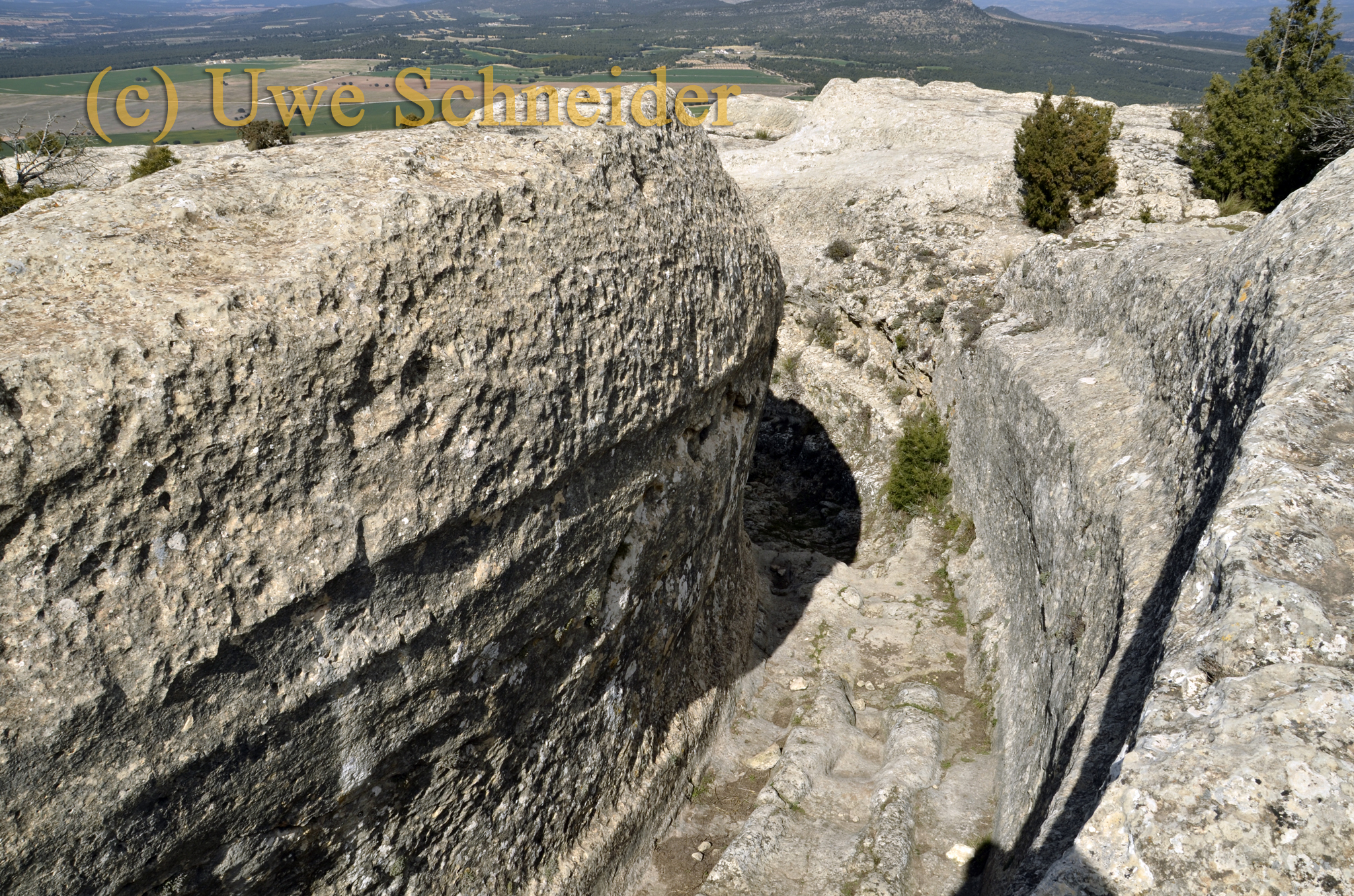
But of course geology teaches that when limescale forms in the sea, it hardens immediately.
So there is a currently unsolvable contradiction between the obvious appearance and what is geologically possible.
We also know the phenomenon of soft and supple areas in the rock from travel reports from Egypt and Peru.
Gigantic, irregular stone blocks were put together so perfectly that no hair fits between the blocks. Such smooth processing marks can also be found in the remaining rock in the granite quarry in Aswan (Egypt).
As an example, use a piece of butter that is not too cold, in which you can leave elegant traces with a knife.

And since this guesswork gives no tangible results, for the sake of completeness we cannot avoid a theory that many other inexplicable phenomena with the visit of cosmic travelers tried to explain.
I think this is an interesting thesis, because there are actually many old writings (e.g. in the Bible and the Mahabharata) about flying and also landing aircraft.
But why should beings capable of interstellar space leave such strange traces?
That makes no sense to me, on the other hand, when looking at the unbelievably smooth parts of many tracks, one often thinks of a technology that could somehow make it possible to „soften“ the rock and easily deform or process it.
That may sound very suspicious and some will shake their heads, but please visit Castellar de Meca and then tell me your impressions and experiences.
However, I don’t think the ET hypothesis is very likely, but I don’t think you can rule it out 100%.
The universe is big, and we would be the only ones who can think and create would be very arrogant.
As far as I know, this idea has been haunted by cosmic wanderers around the world since the 1960s (see also introductory text to Malta).
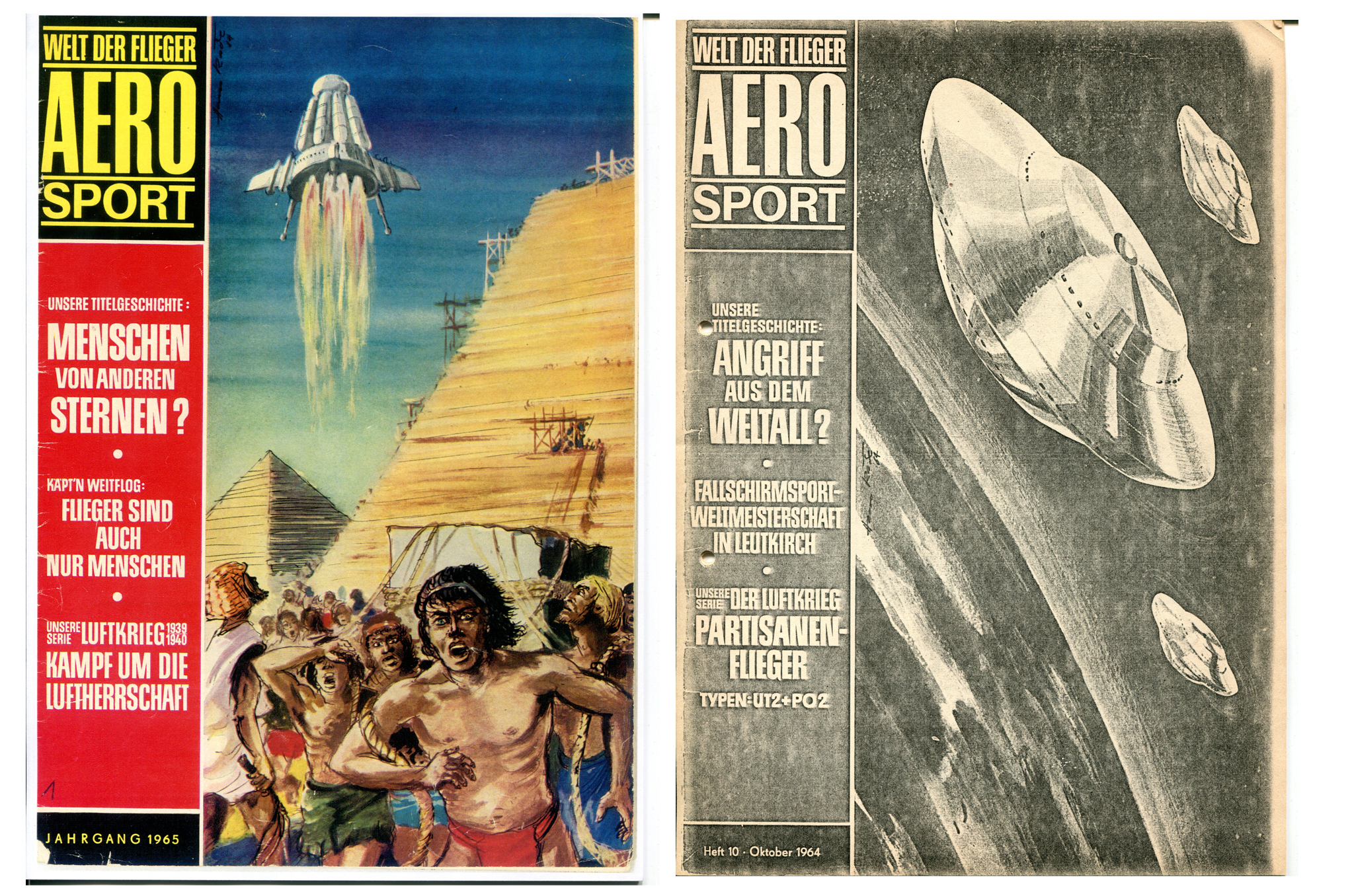
5. What’s next?
The most important question for me is the age of the tracks!
The archaeologists should not be presented until reliable results have been obtained from several geologists and geomorphologists working independently of one another.
Without concrete morphological and geophysical results, all statements on the subject are only pure speculation!
Based on the current state of affairs, it looks like that, in addition to the research results of Dr. Alexander Koltypin, there is no information on the age of the traces.
As far as I know, he is the only researcher who deals intensively with this topic and publishes his thoughts, results and theories.
However, according to information from Hans-Dieter Gau, research is also being carried out in the Azores, and it is to be hoped that concrete results will soon be available.
It is a great mystery to me that almost 50 years after the first manned moon landing on the subject of cart ruts, there are still no safe and recognized research results!
Of course, if Koltypin’s thesis is correct, it is difficult to imagine that the traces are millions of years old.
There is a danger and it will surely also happen that his statements will be swept aside by conservative science without verification, as they would bring the entire historical building to collapse.
But if we look at the word science, we should be aware that we have to be open and open to new ideas, otherwise it will be impossible to create new knowledge!
The traces with all their bizarre properties exist in real life and the facts don’t just disappear if they are suppressed or hidden!
Unfortunately, it is widespread nowadays that important details and facts are withheld from the general public, without which the true relationships cannot be recognized.
Dogmas bring no one further and curiosity is a wonderful and deeply human quality.
Our minds should not be hampered by shackles, even if they take on adventurous features once in a while!
Without imagination and creativity there is no new knowledge and no progress.
And it shouldn’t be a shame if a thesis should turn out to be wrong, the history of science knows enough examples of this.
And, to come back to this, this project is intended to encourage interested travelers to participate in collecting data (location description, possible coordinates, type of rock, dimensions and photos).
It is very likely that I will not be able to visit all of the cart ruts areas on this planet myself, so it would be a great win for this project if as many interested and curious people as possible were involved.
KONTAKT
Swell :
01. The unexplained rock tracks of the old world,
A suggestion for further research, Uwe Topper, Berlin · 2008 http://www.ilya.it/chrono/pages/gleisedt.htm
02. Roman roads in Bosnia and Hercigovina
Philipp Ballif, Vienna 1893
03. Cart ruts and their impact on the Maltese landscape
David H. Trump, Malta 2008
04. http://www.stefan-ramseier.ch/roemisch/gastautor/brunner/haupttext.htm
05. The Significance Of Cart-Ruts In Ancient Landscapes
Malta, 2005
06. http://earthbeforeflood.com
personal correspondence with A. Koltypin
